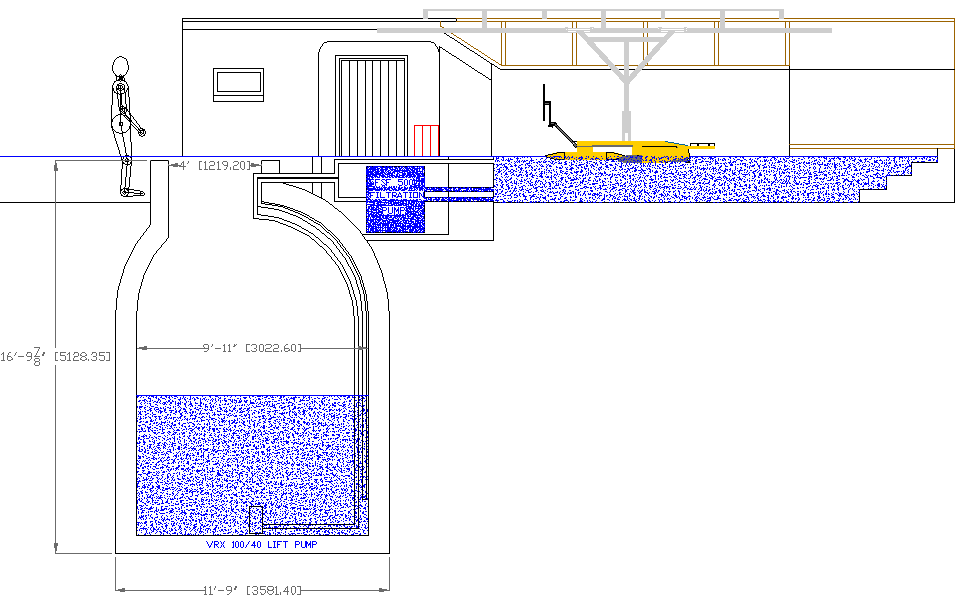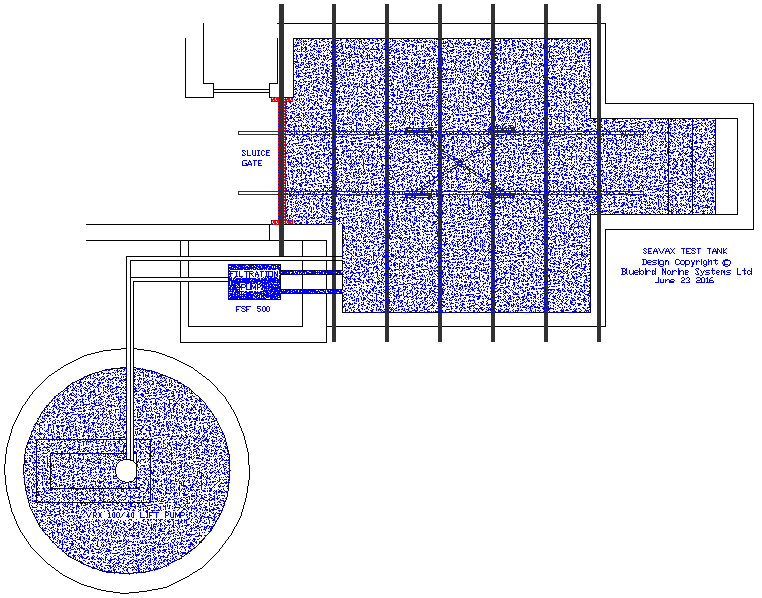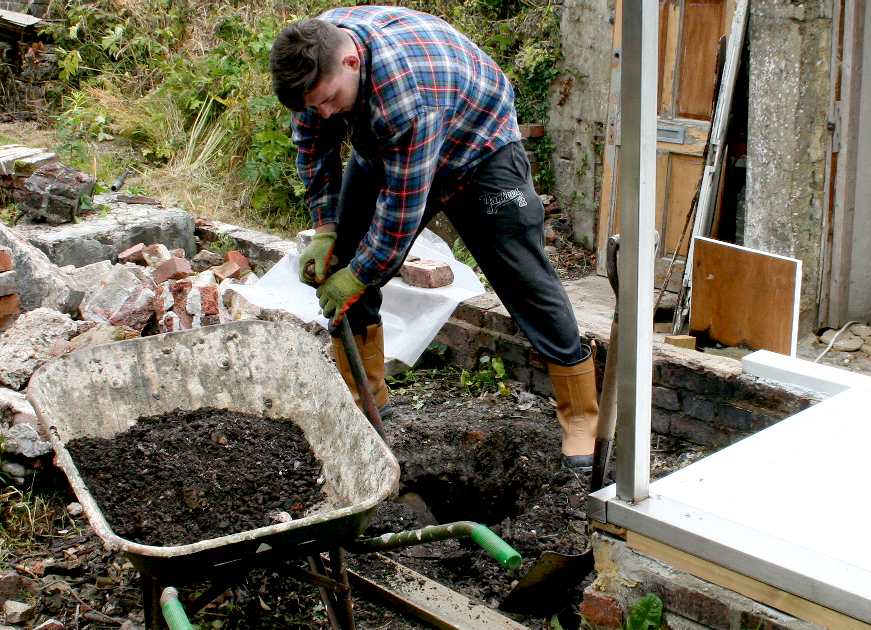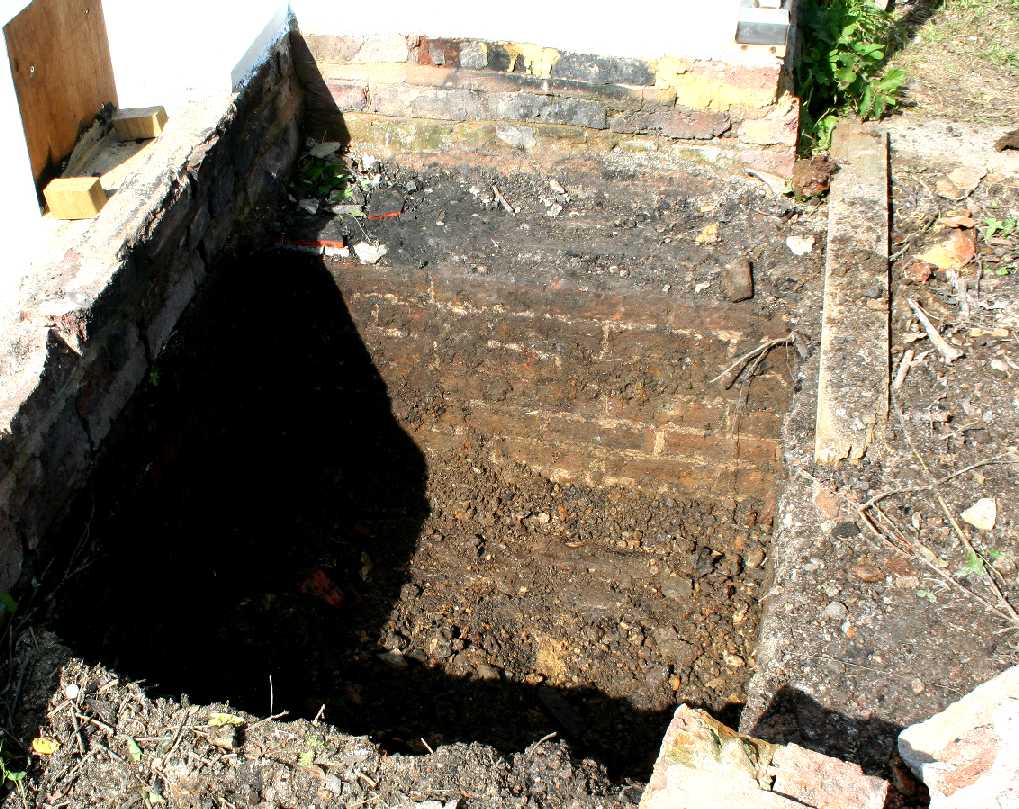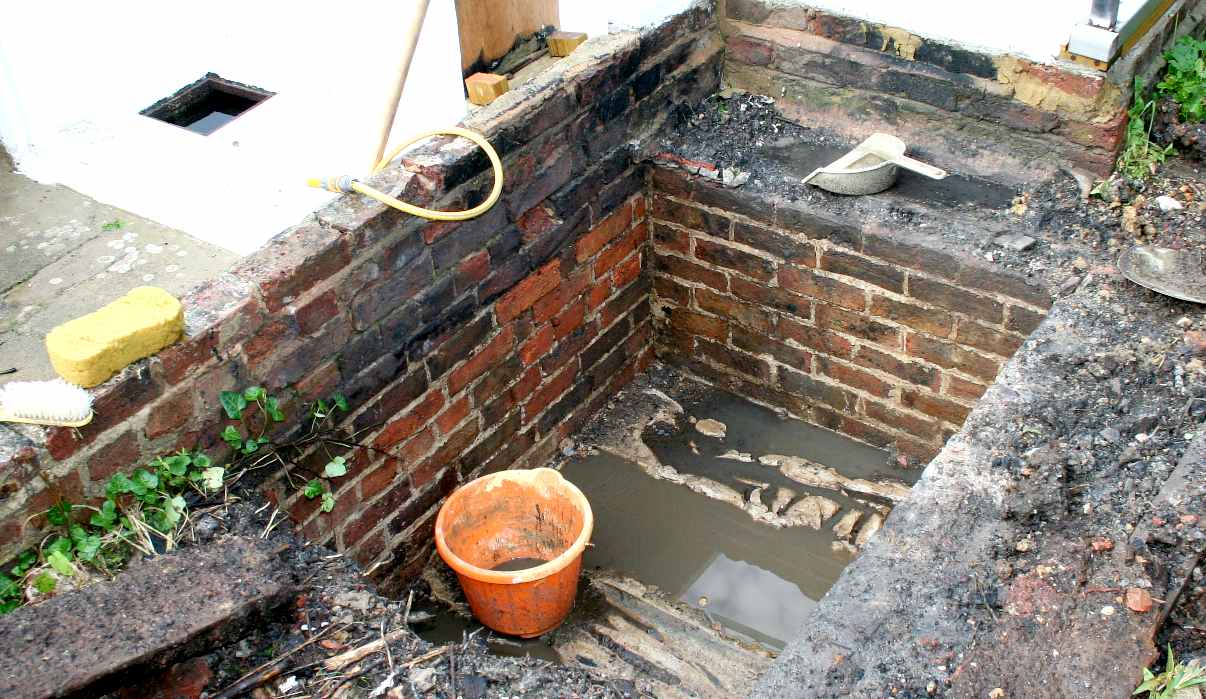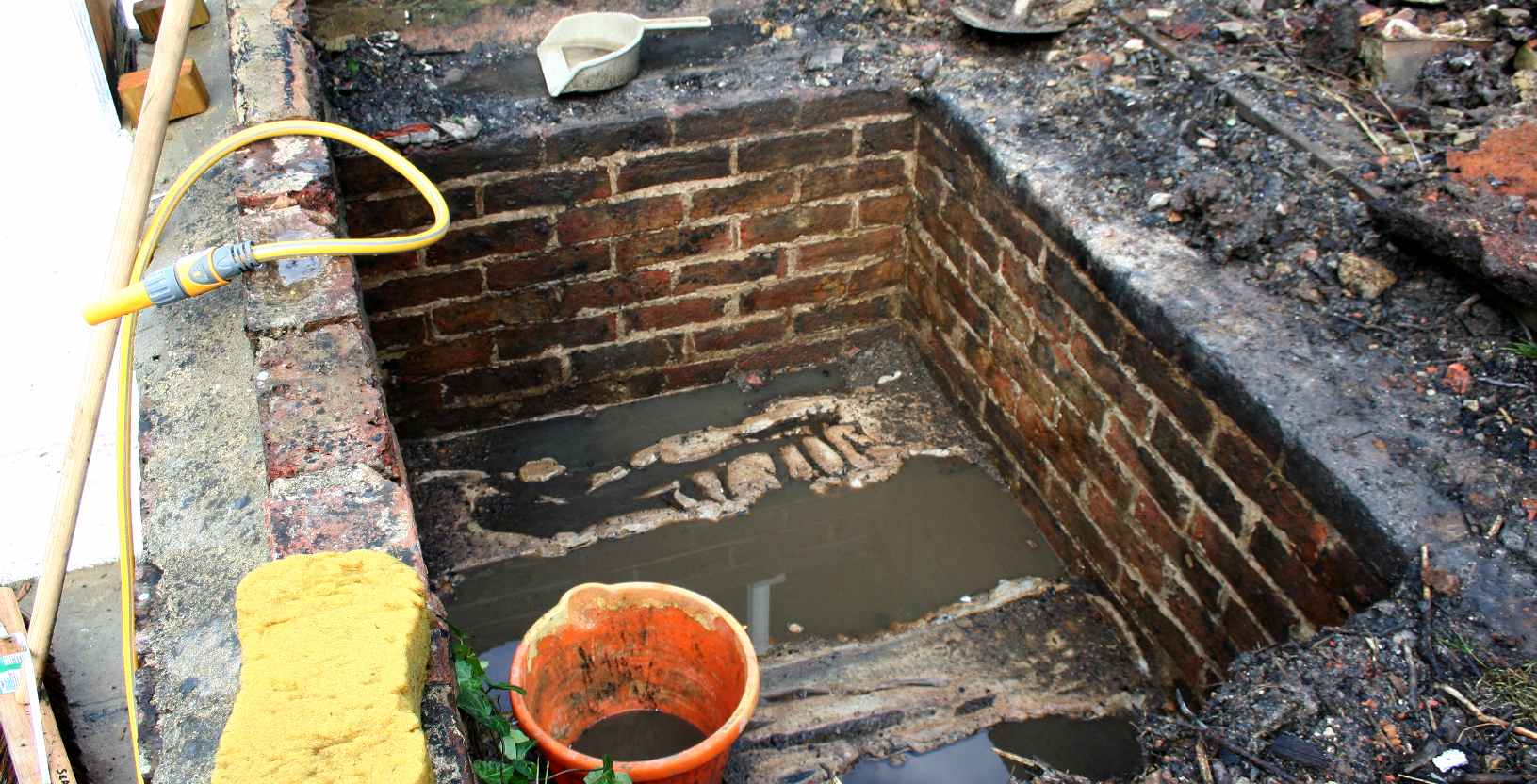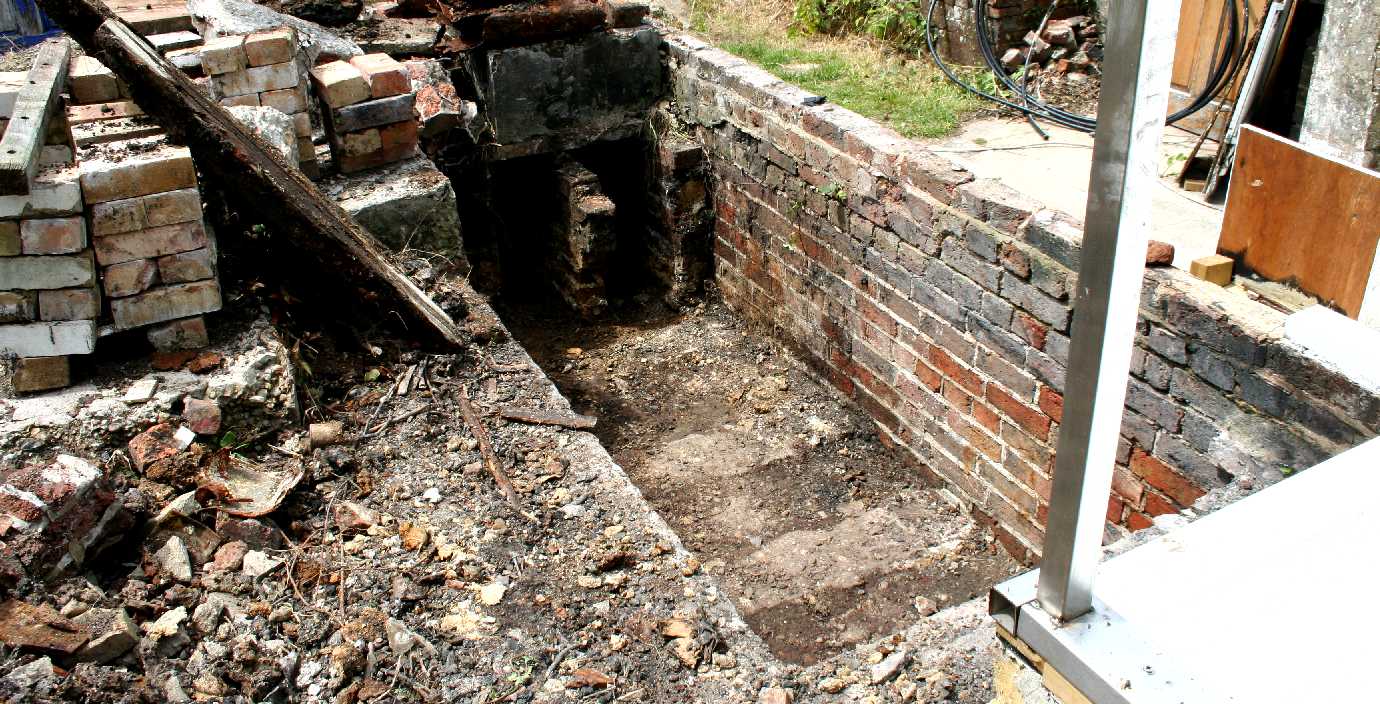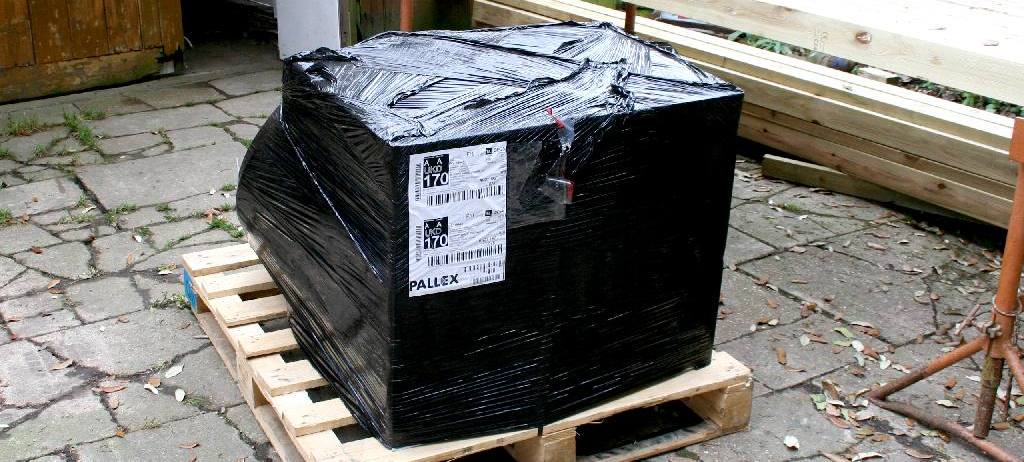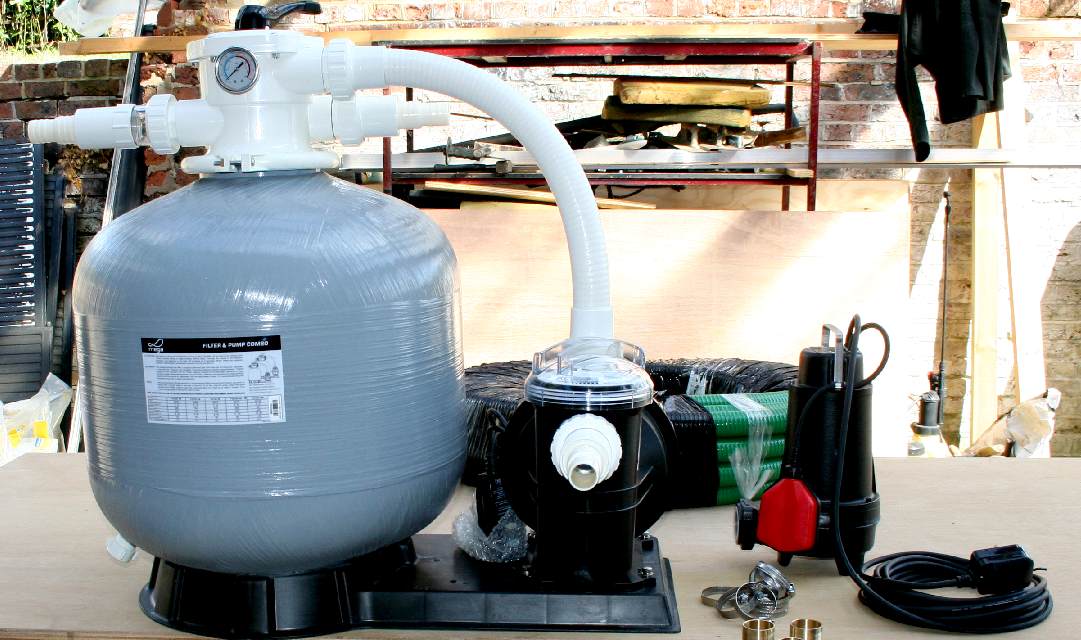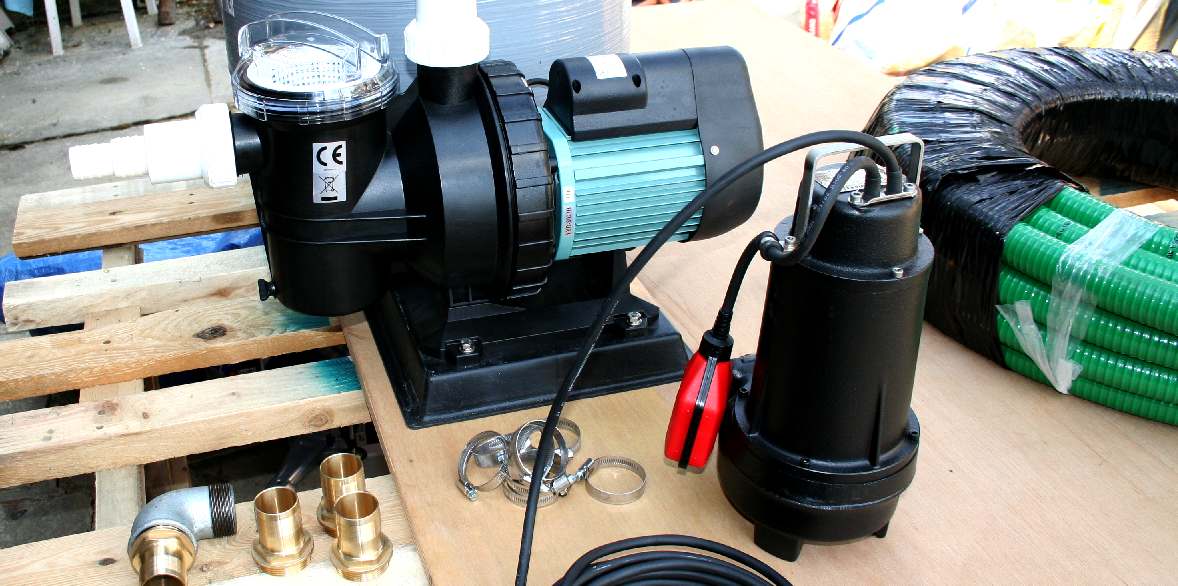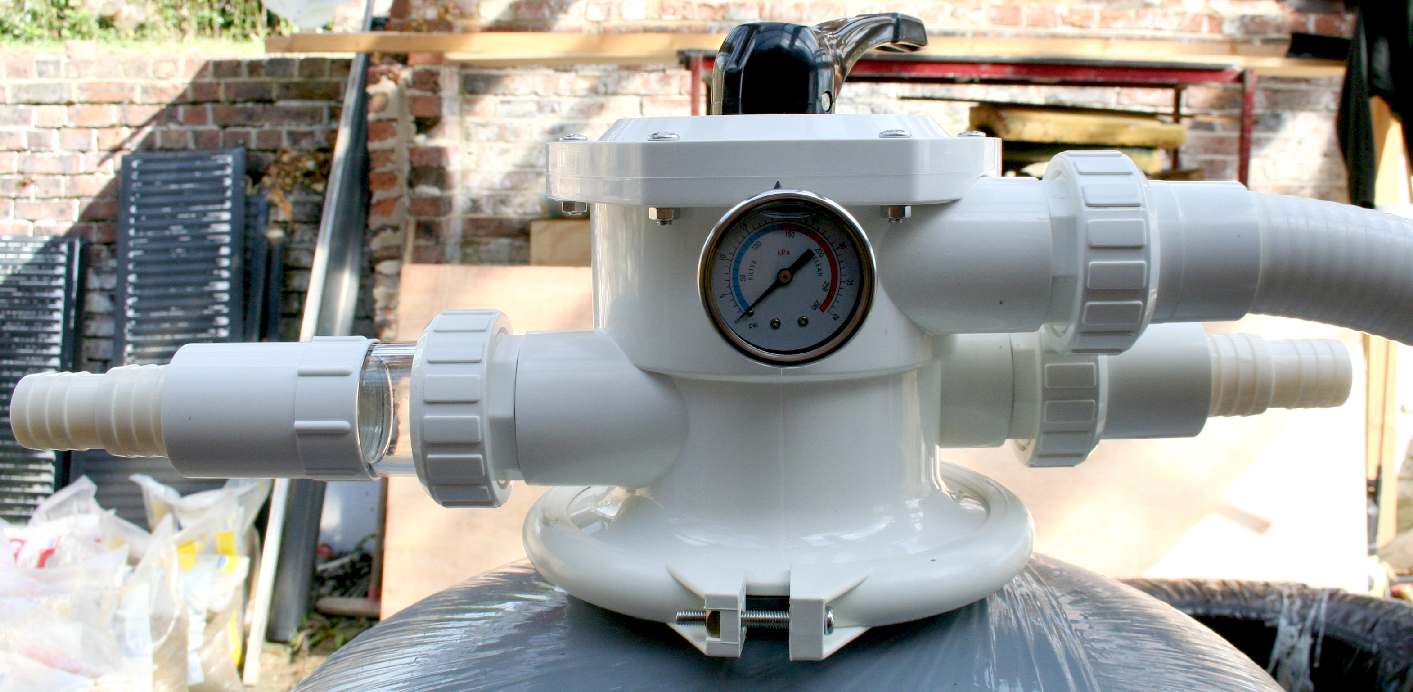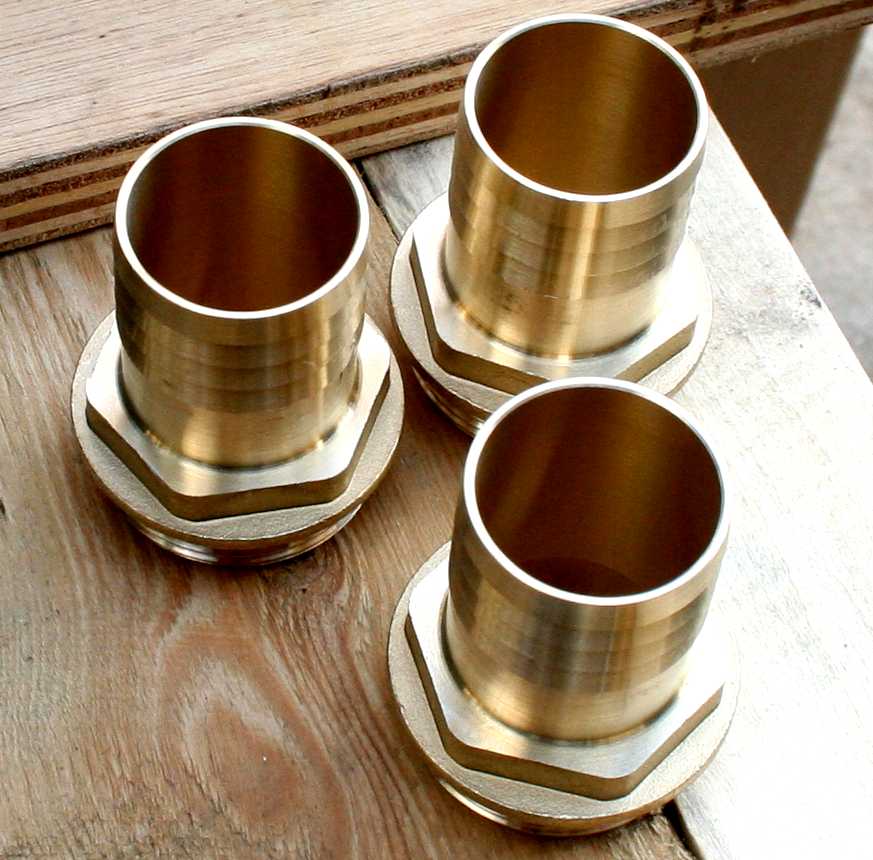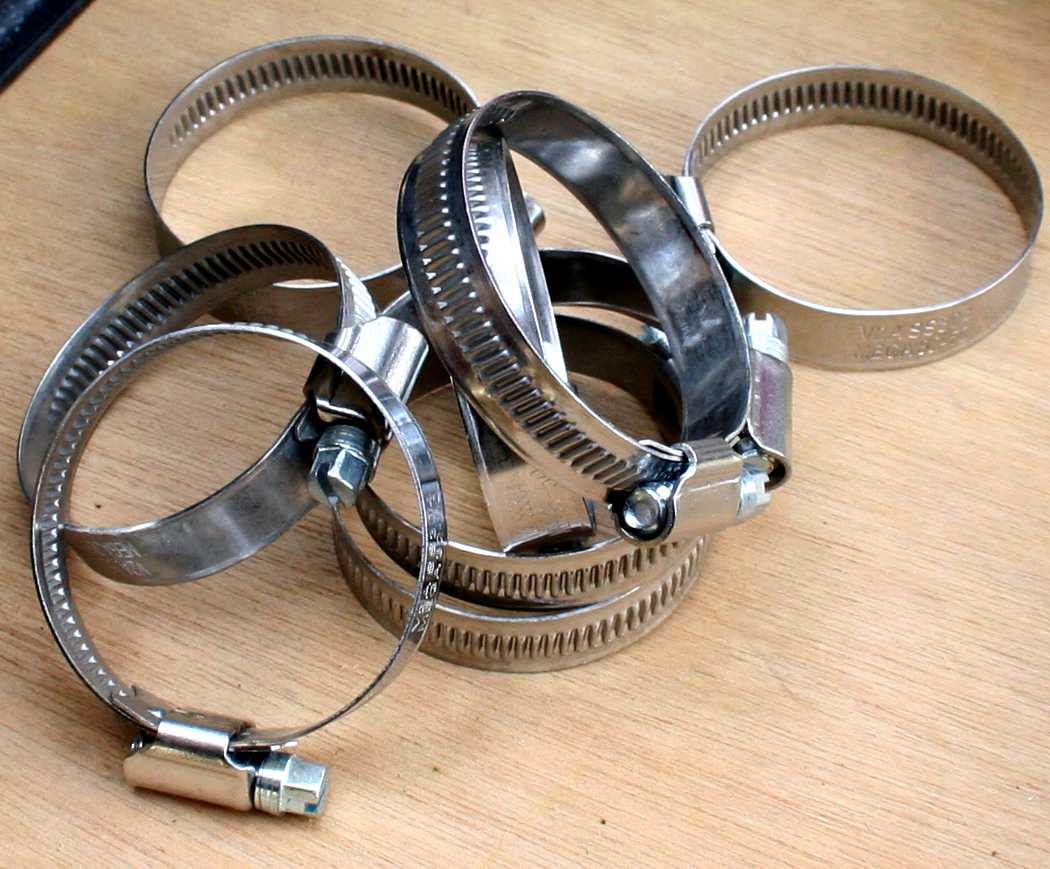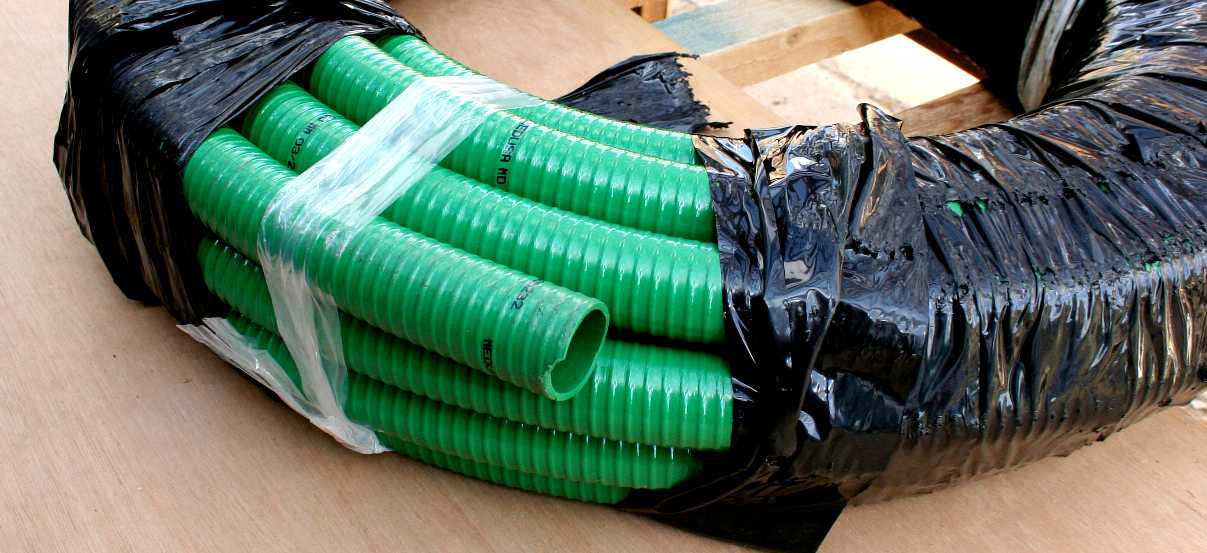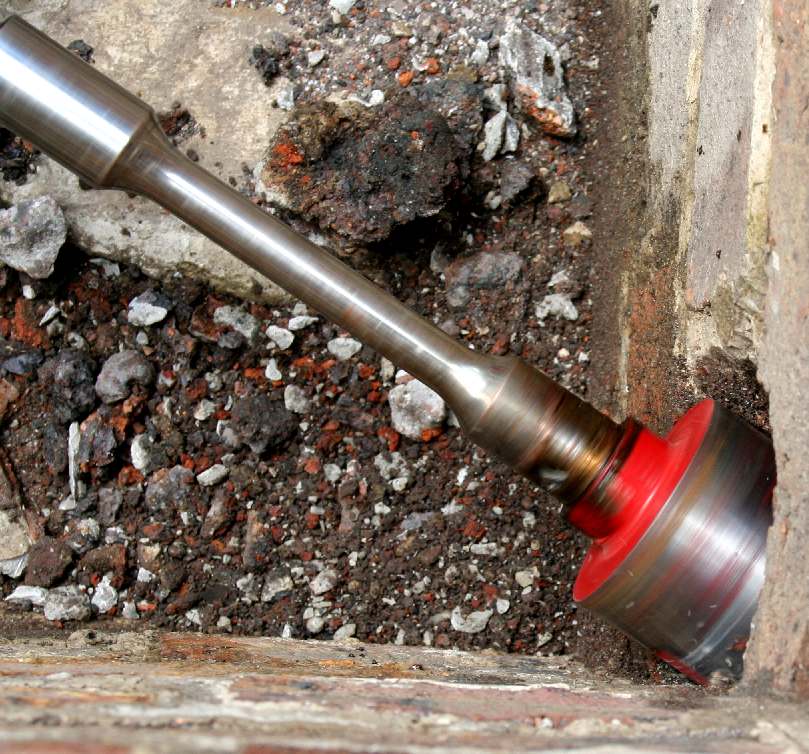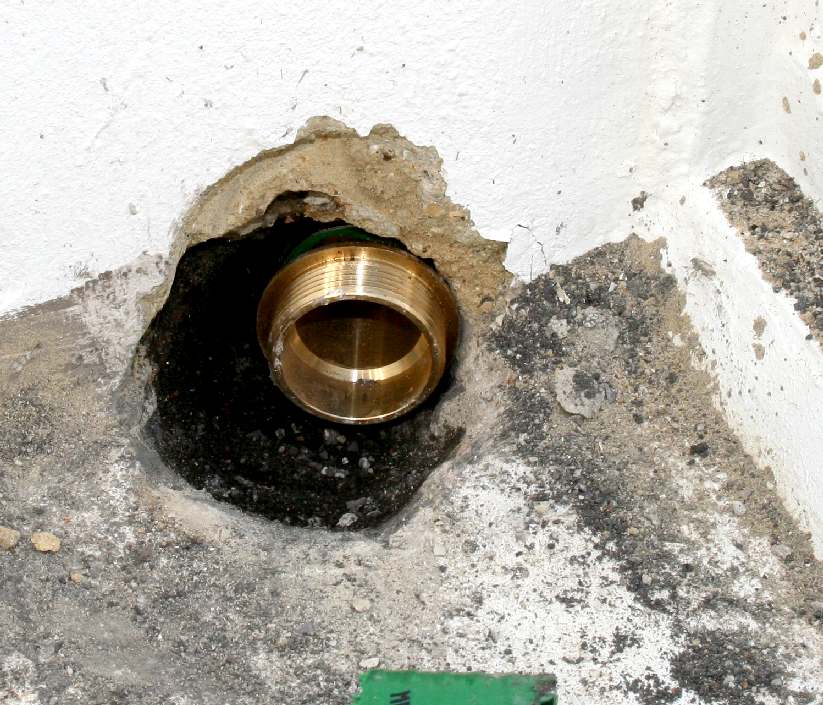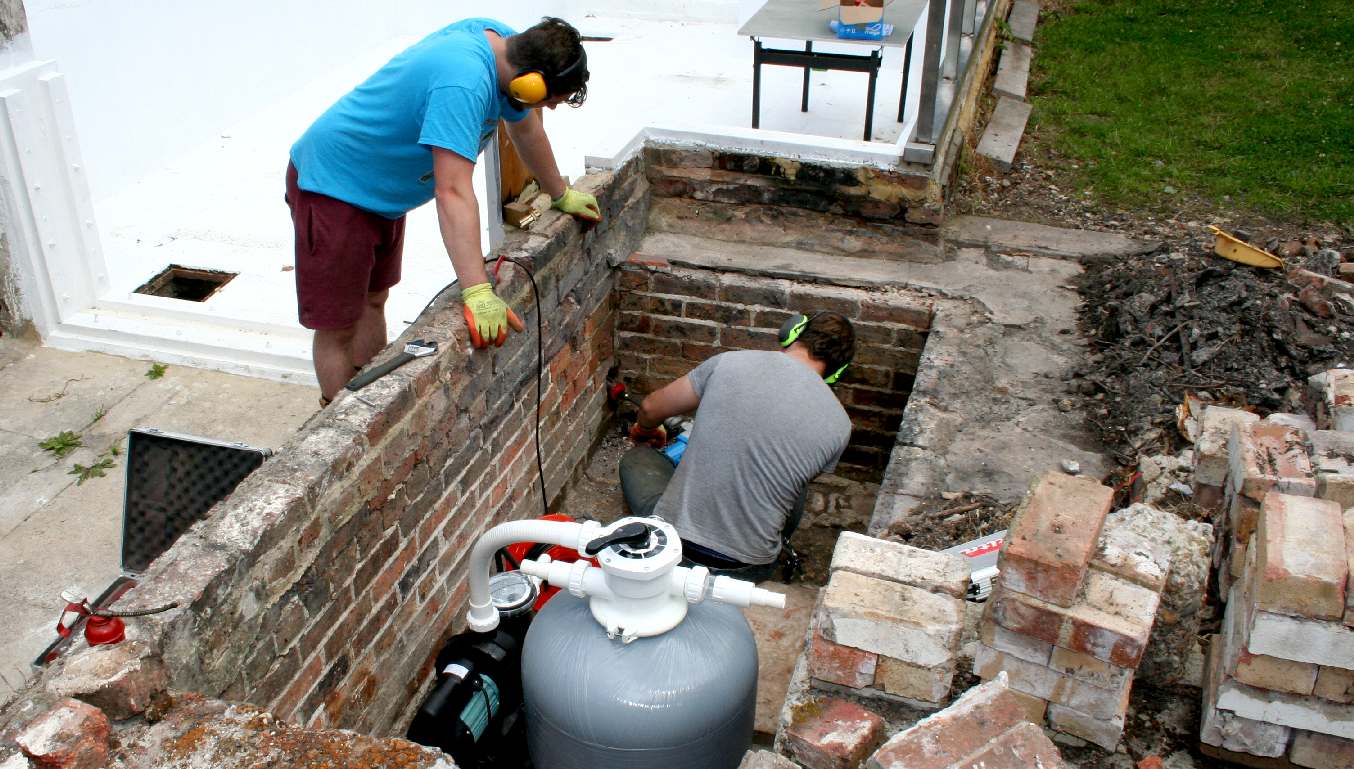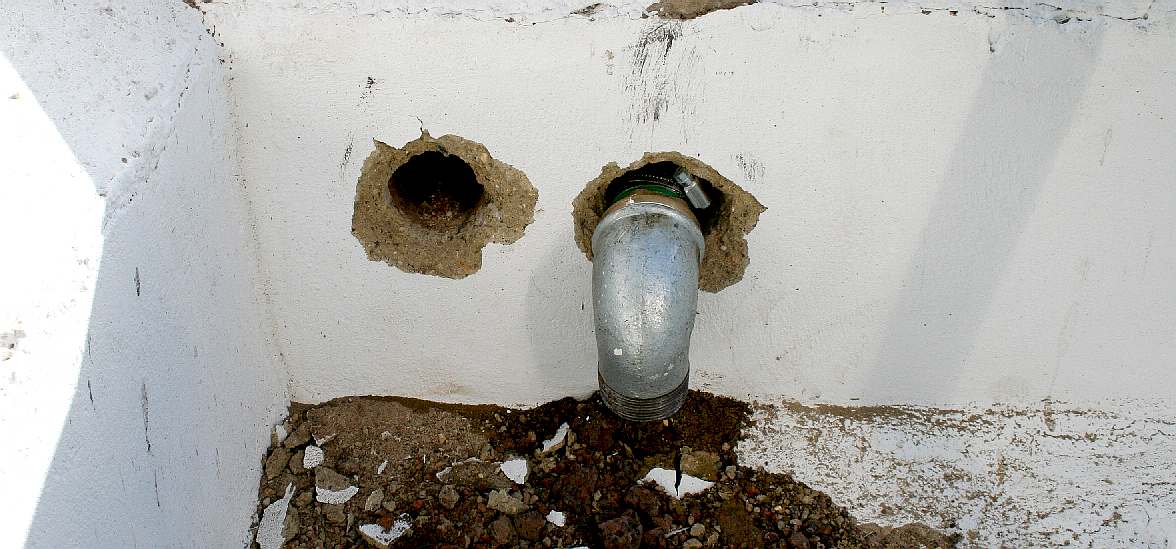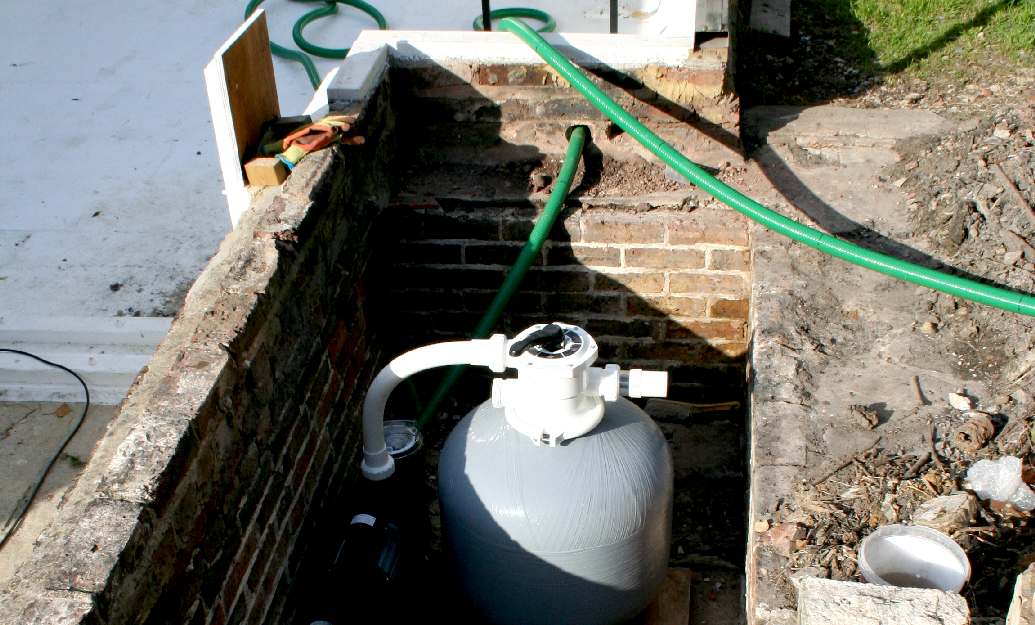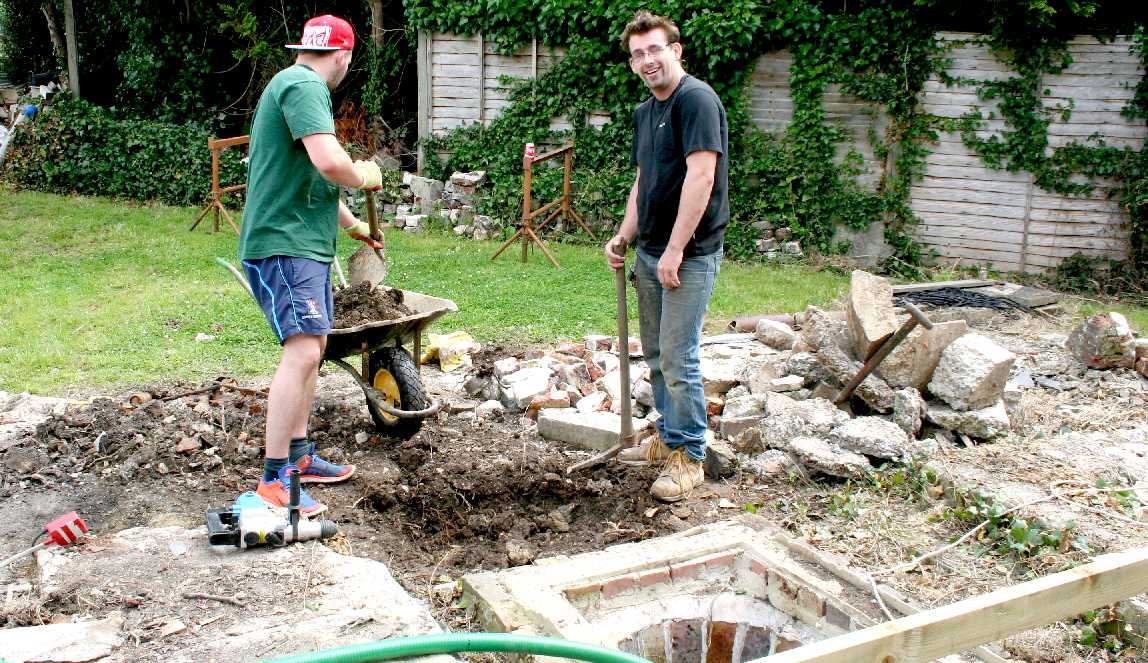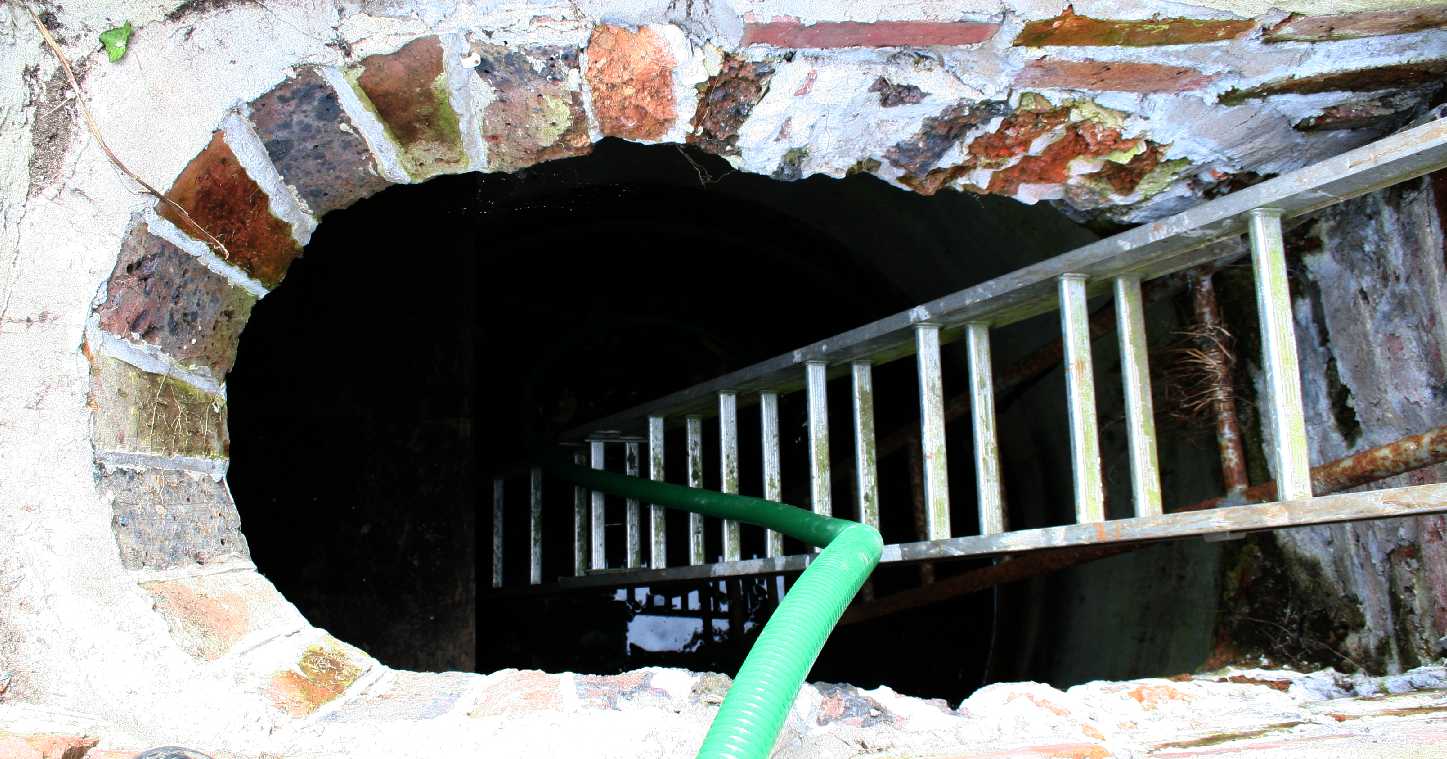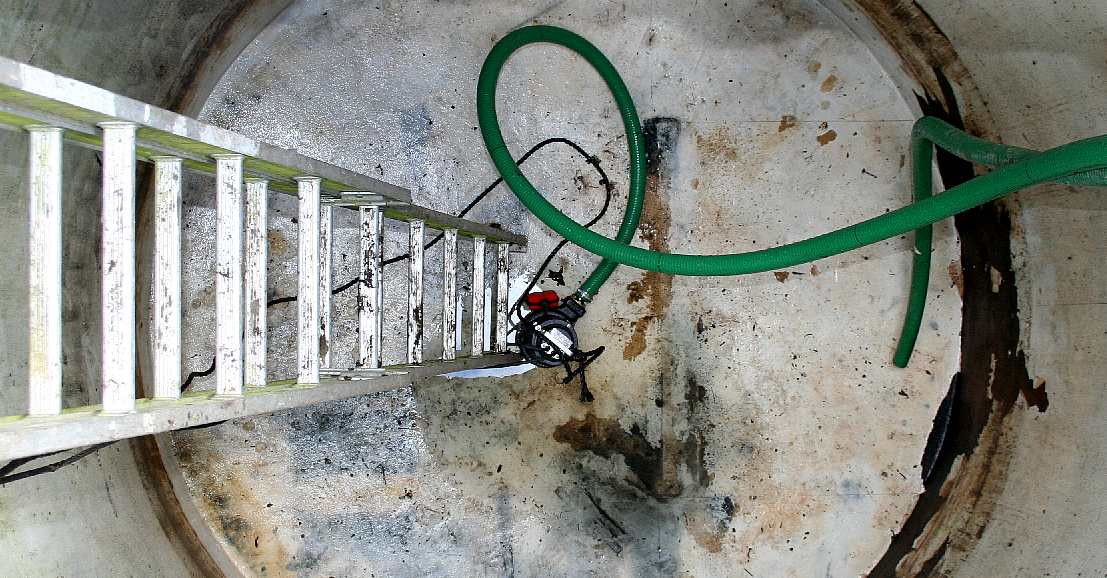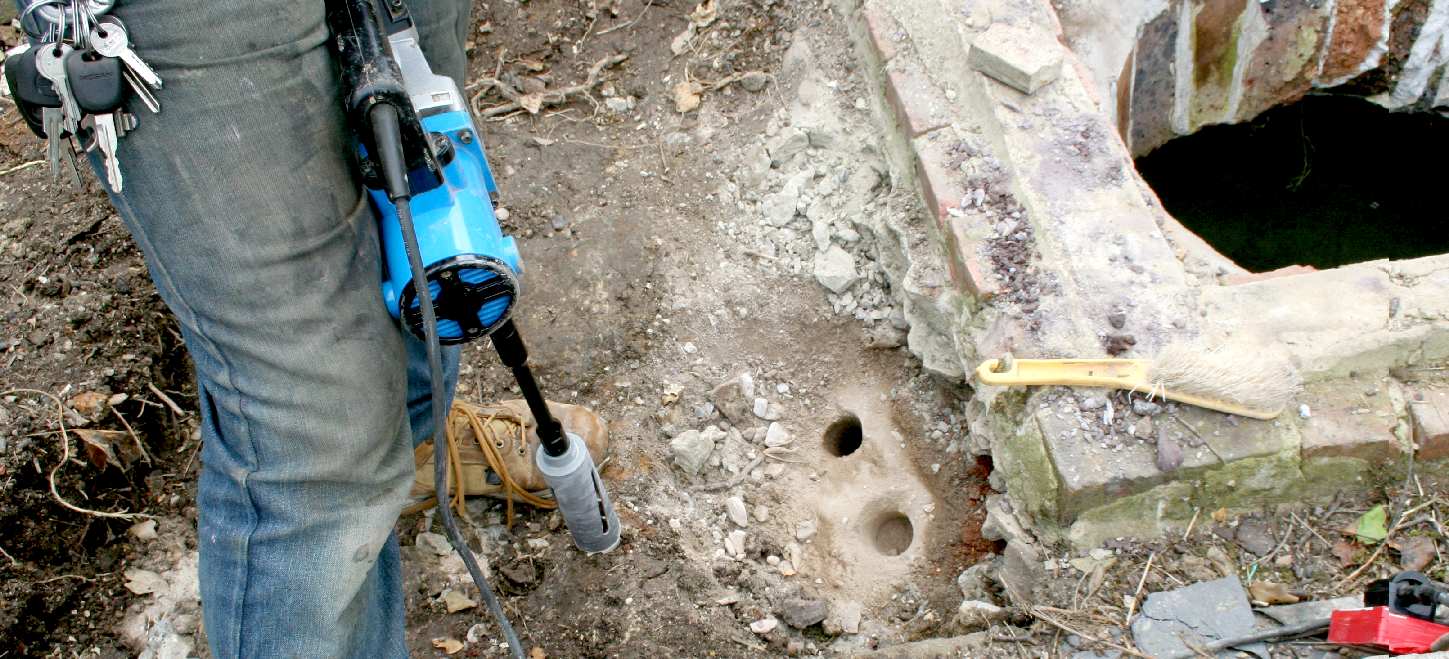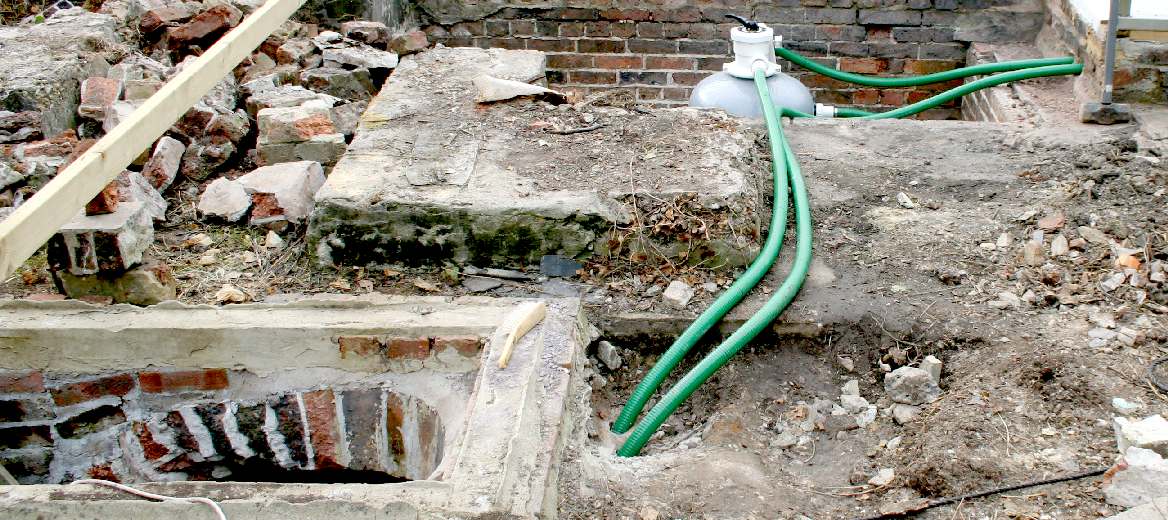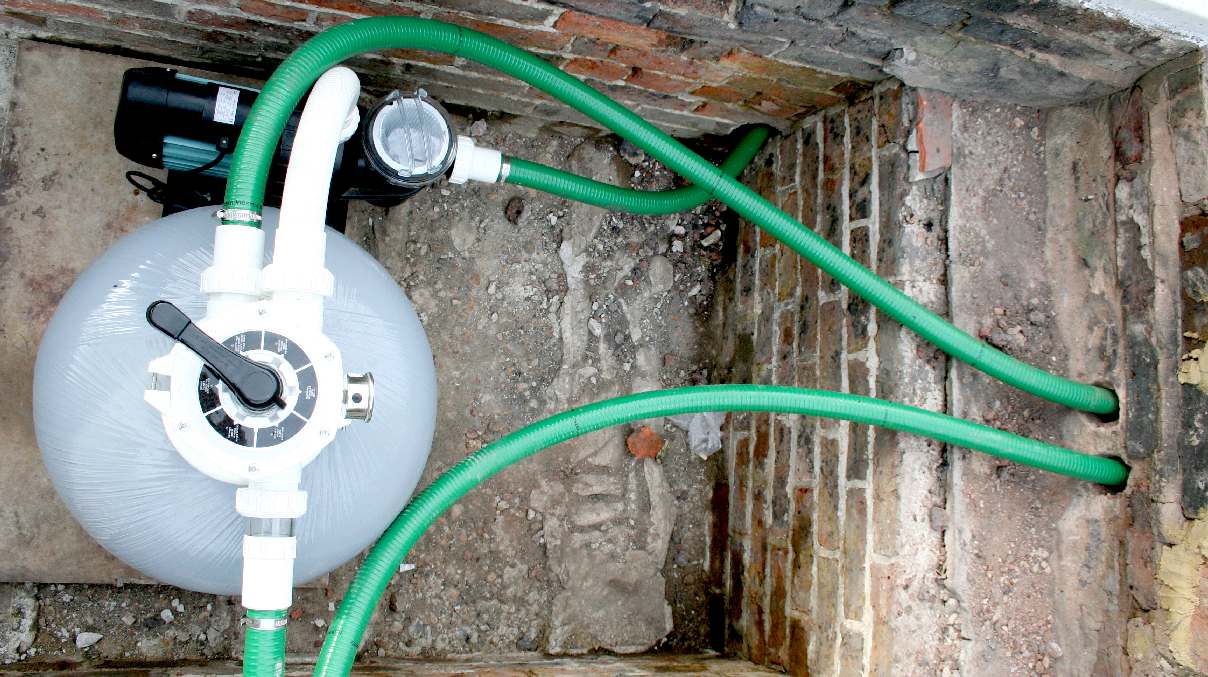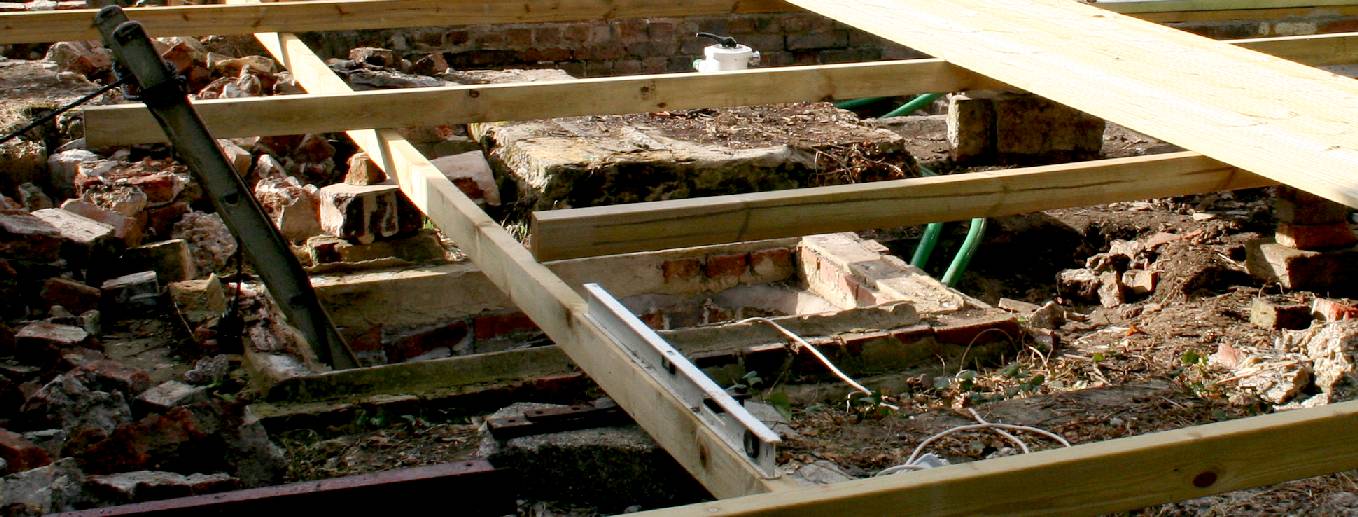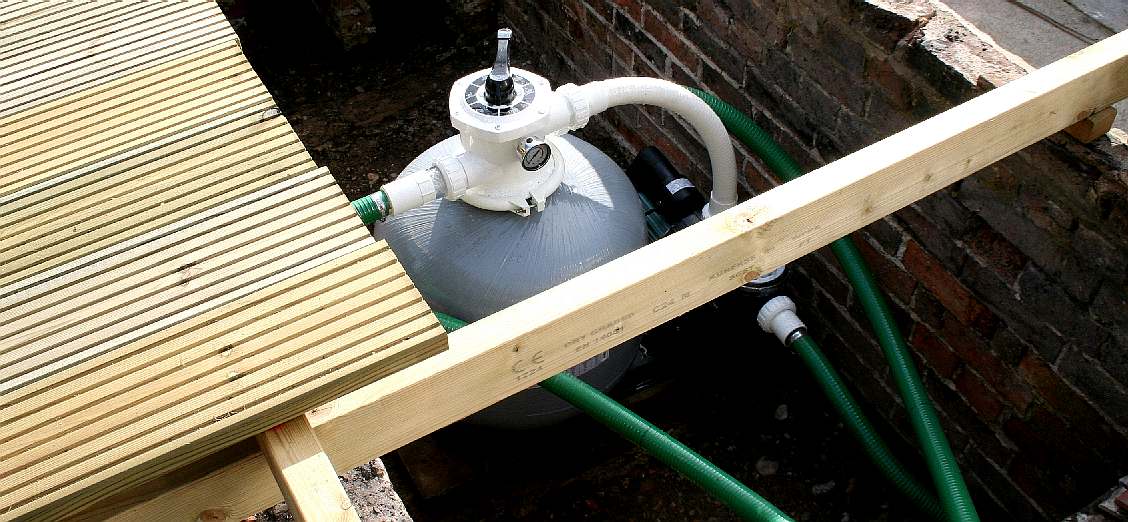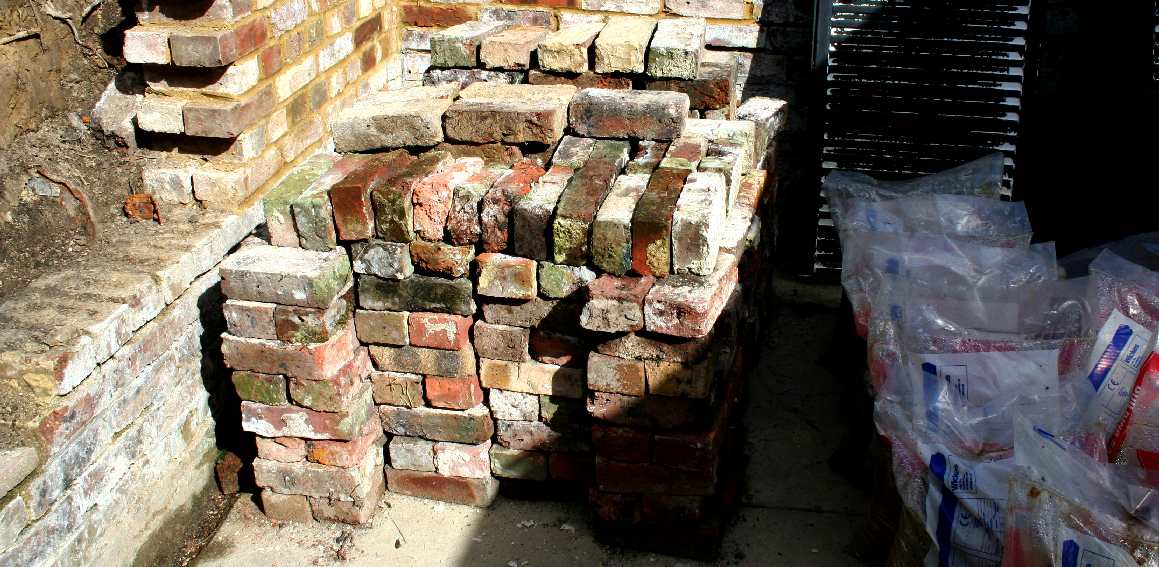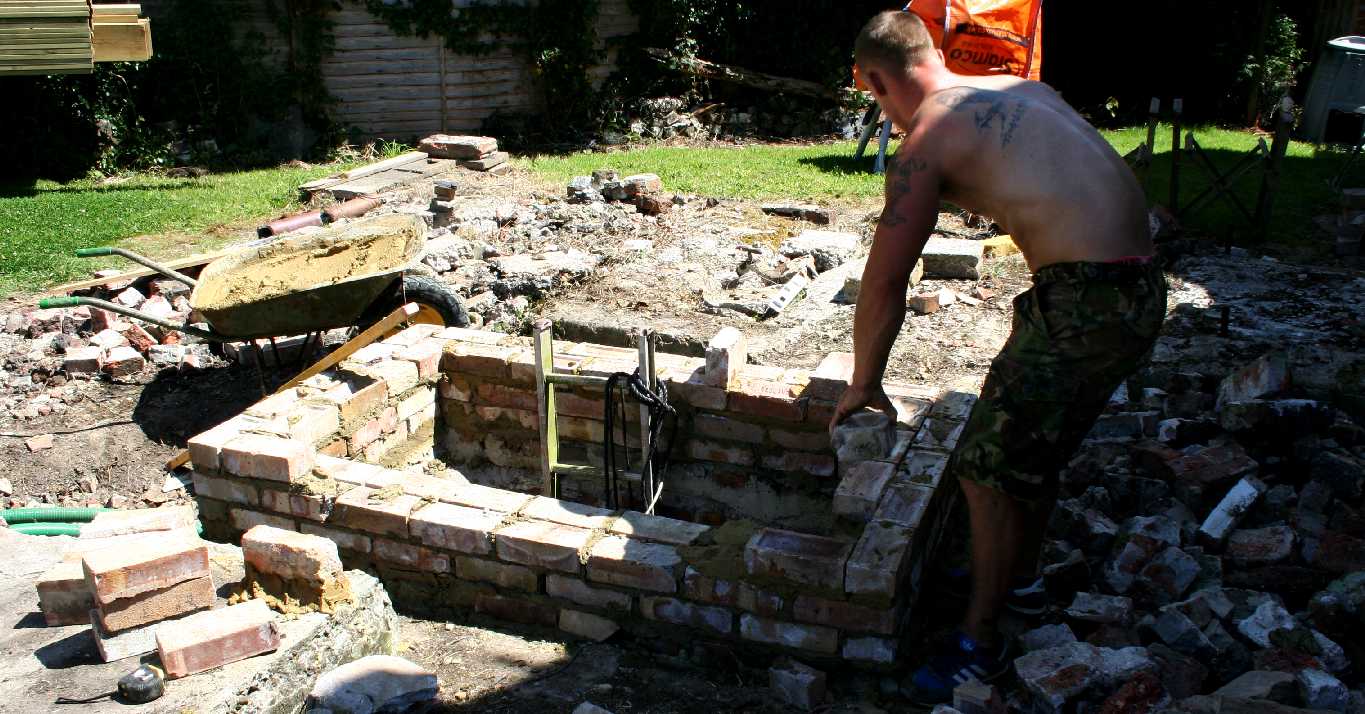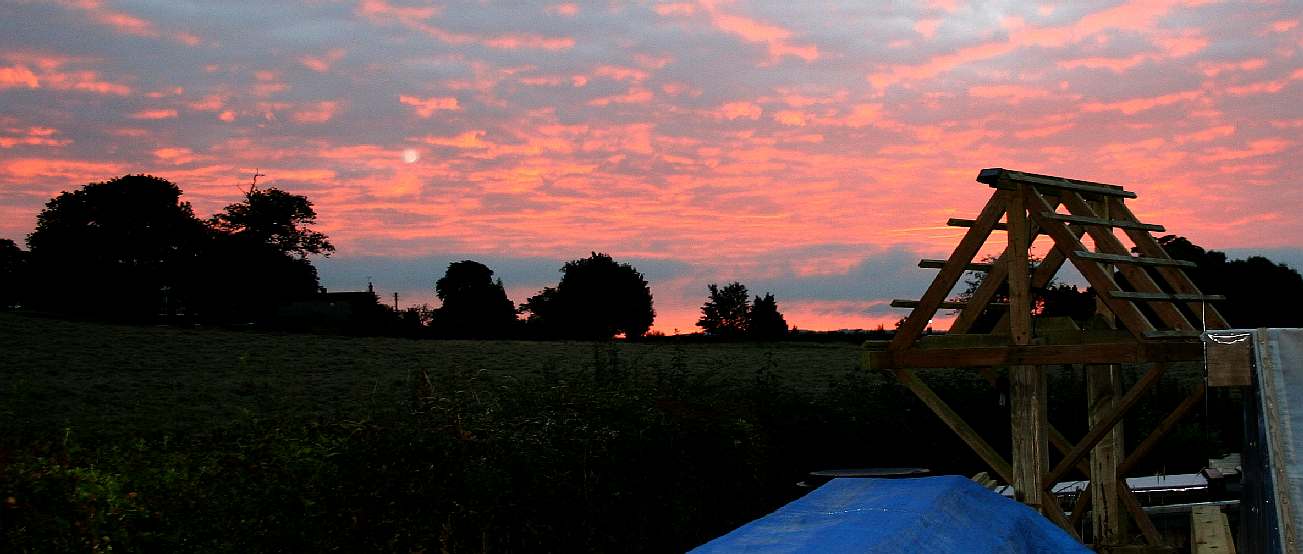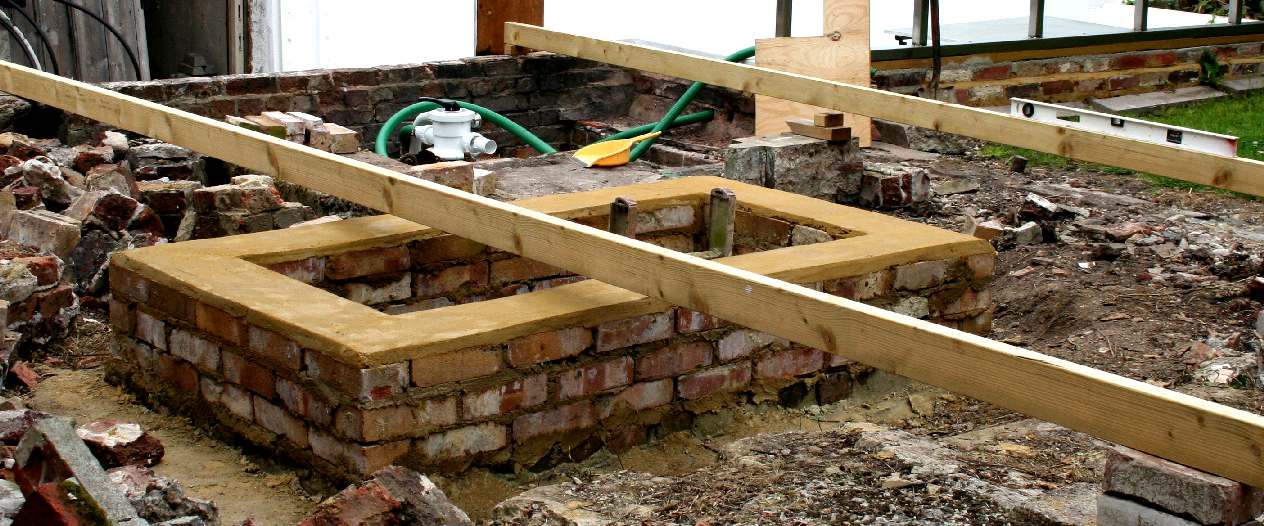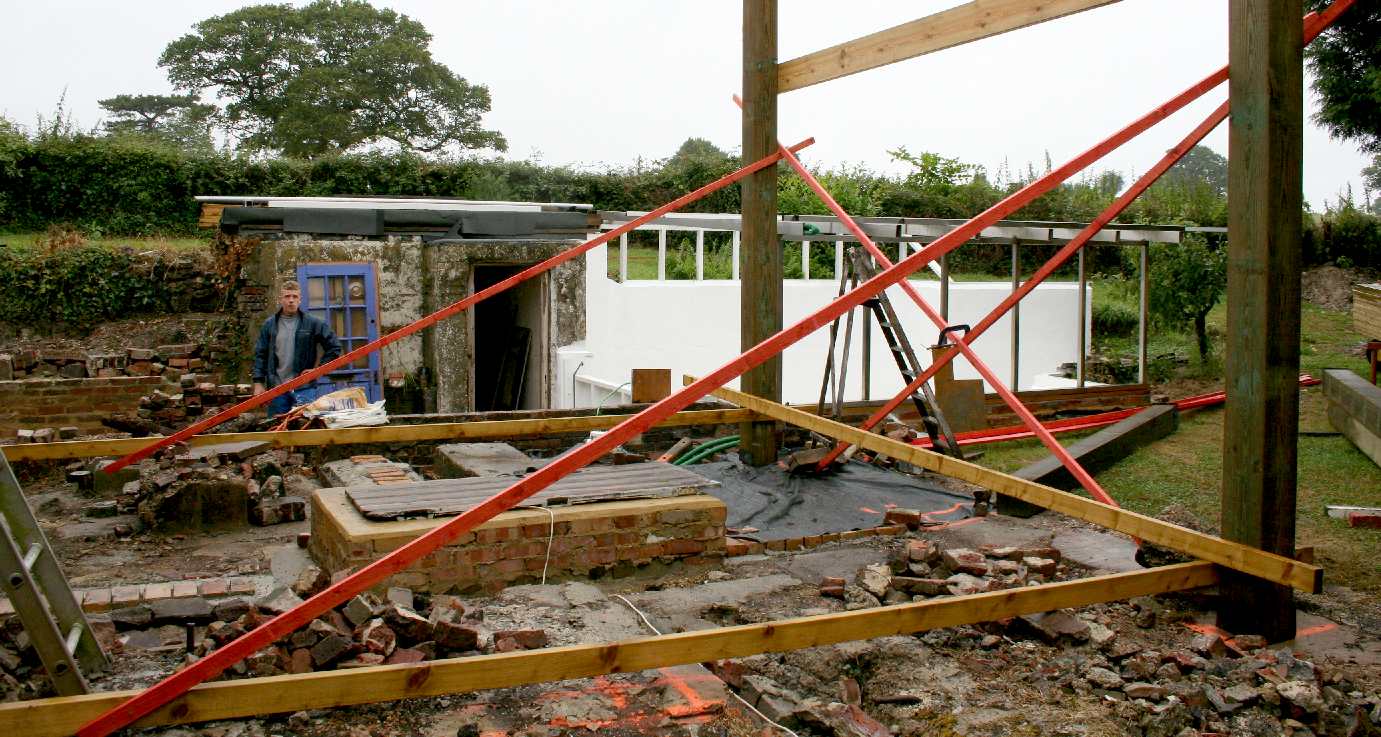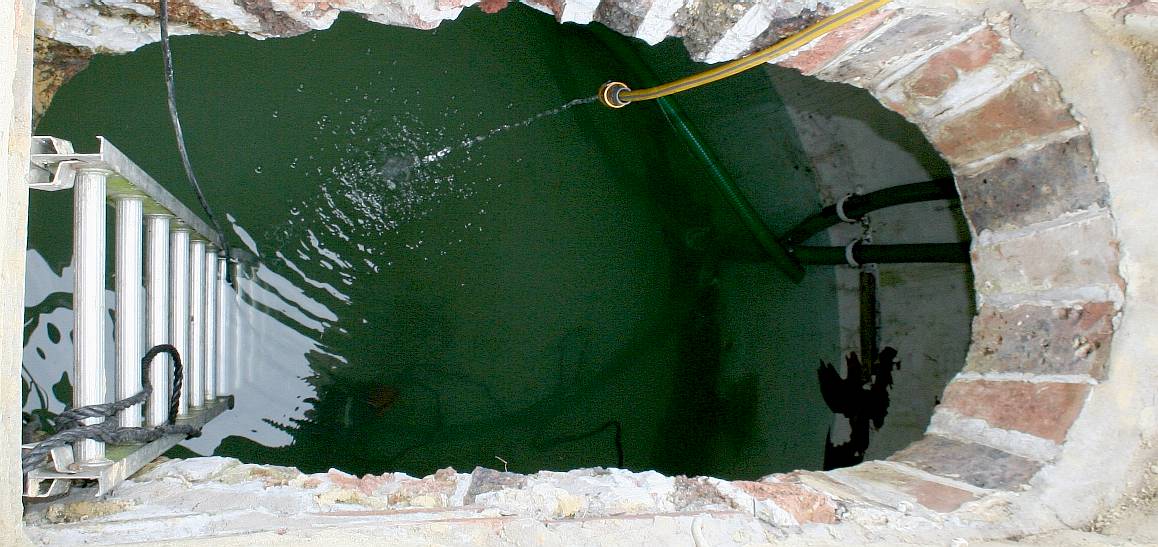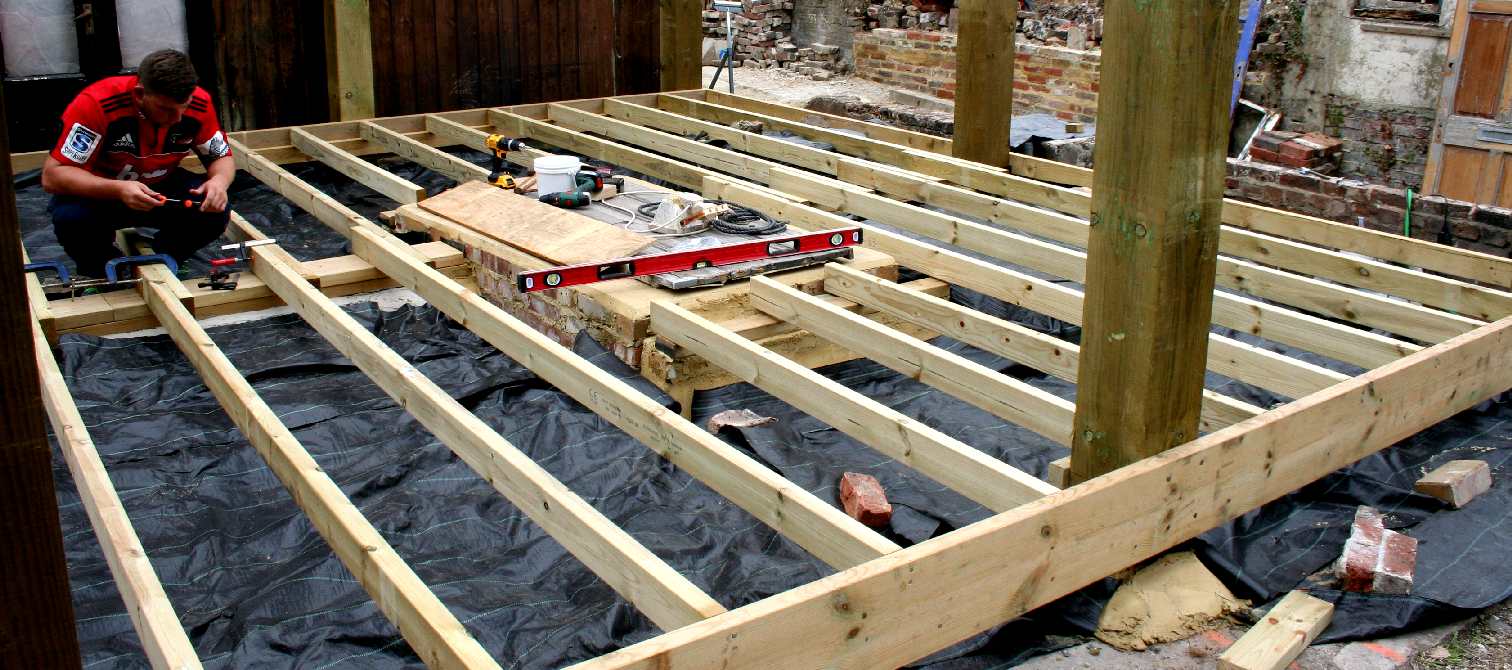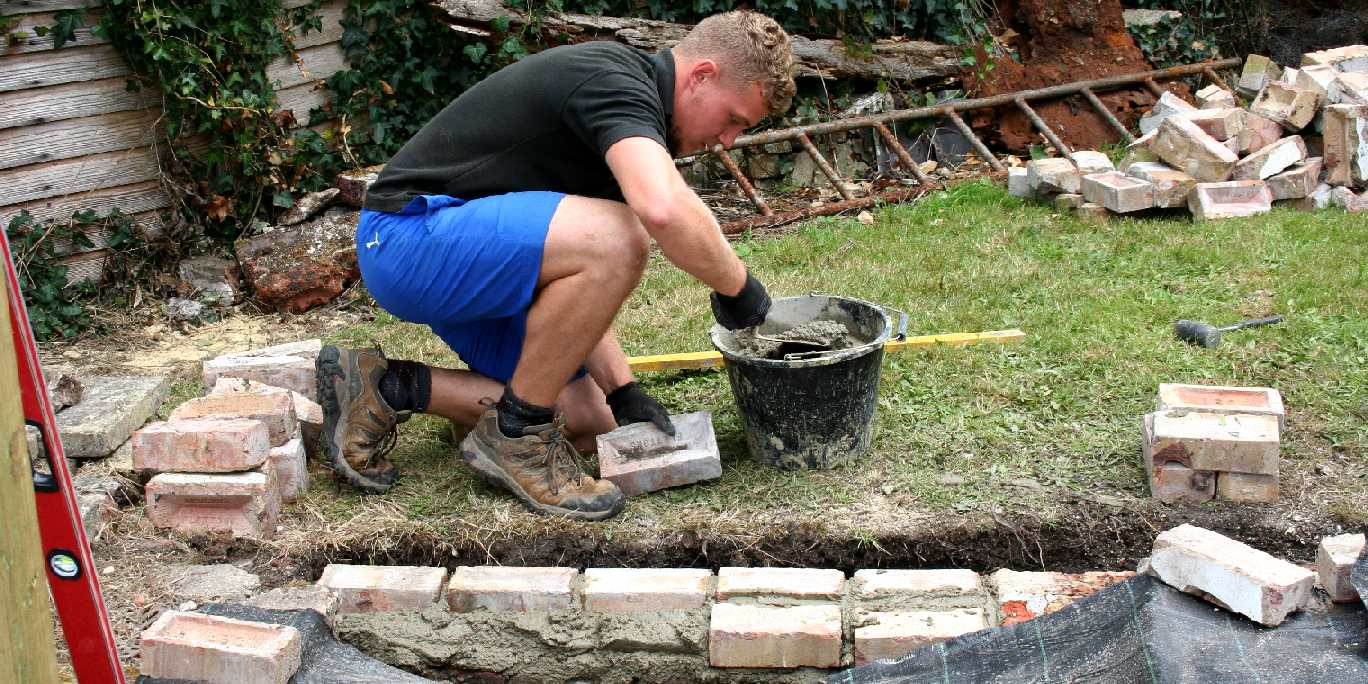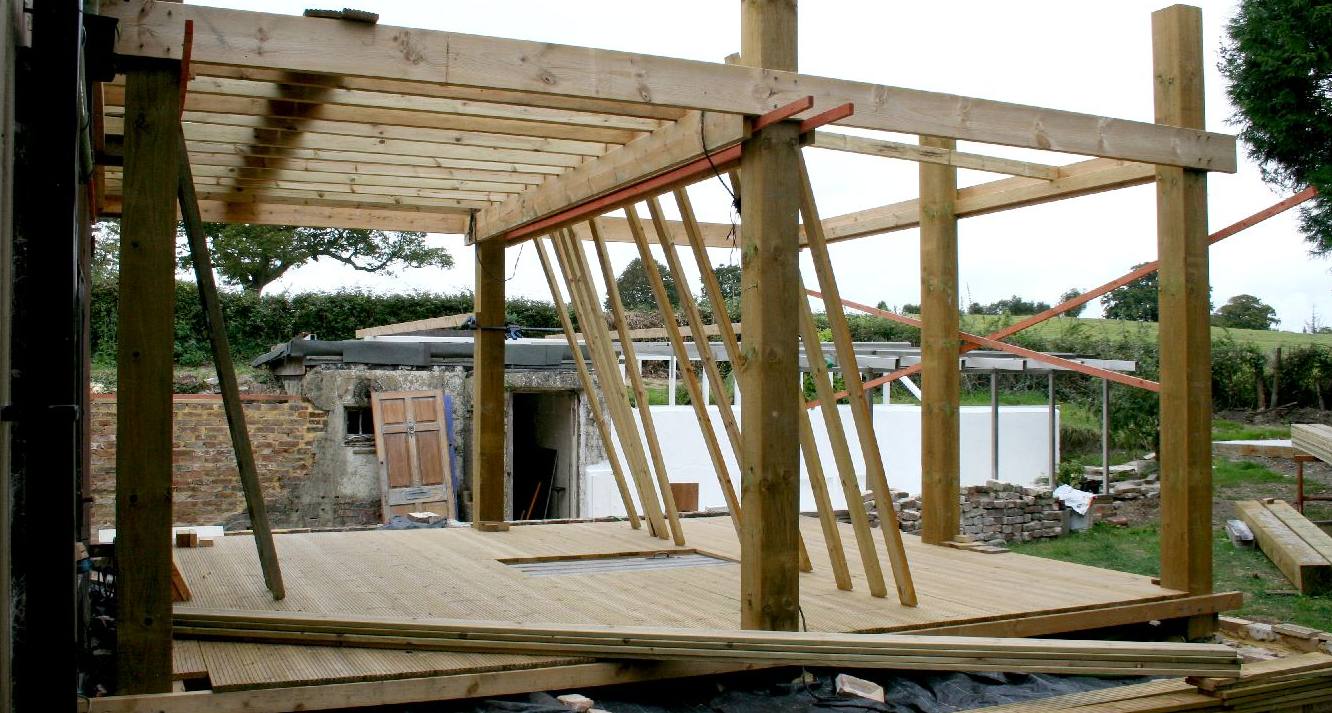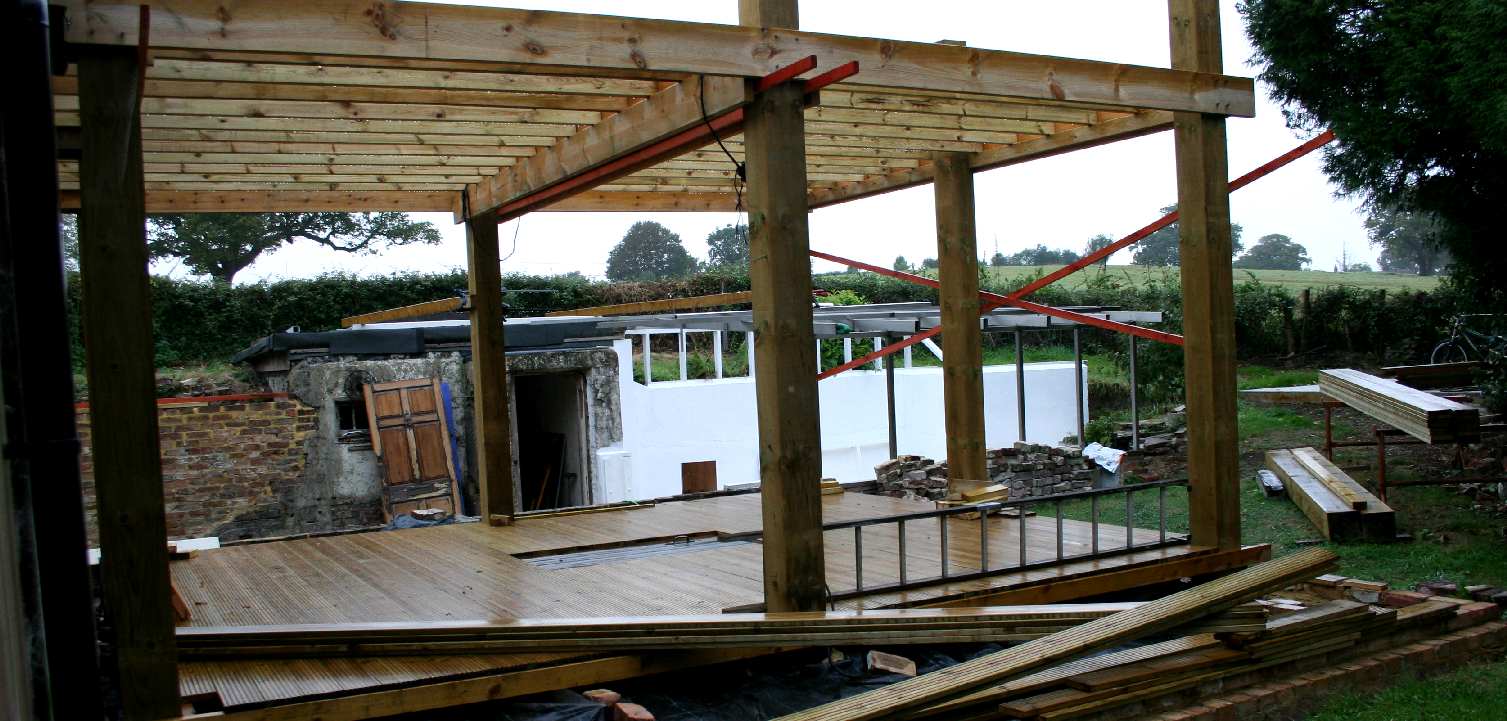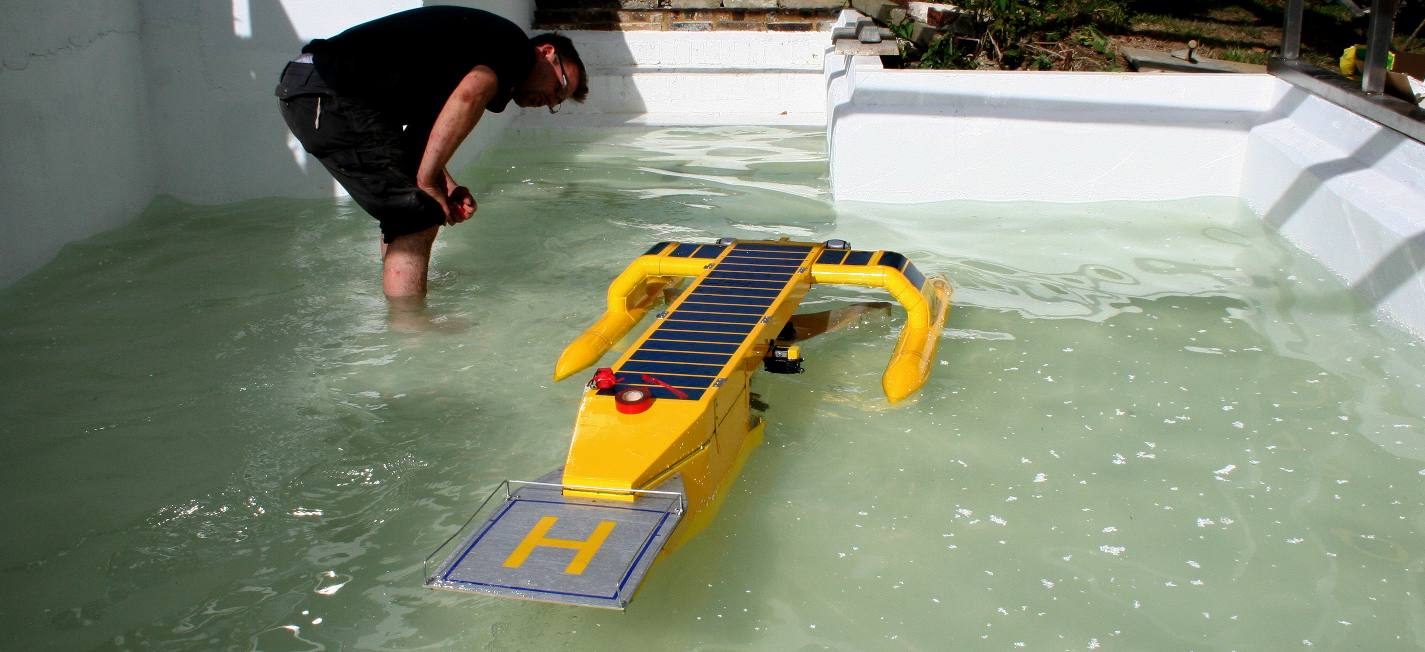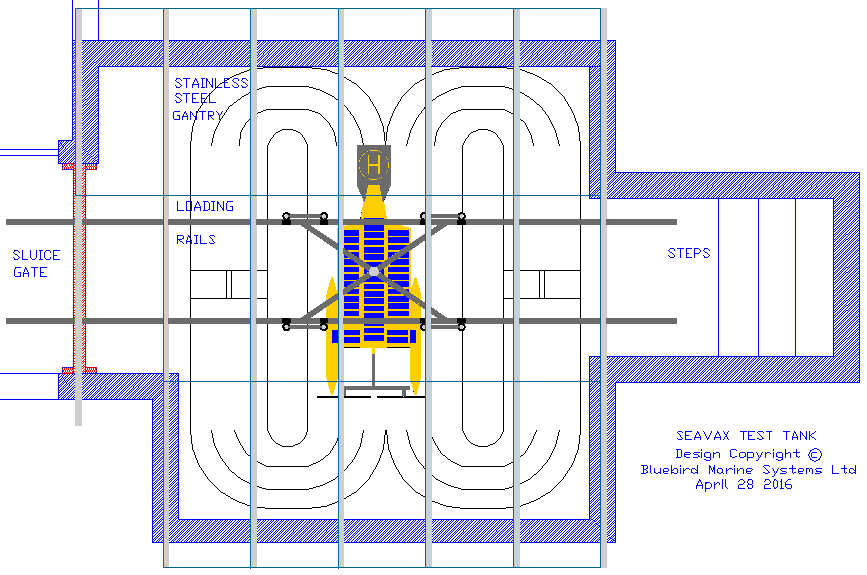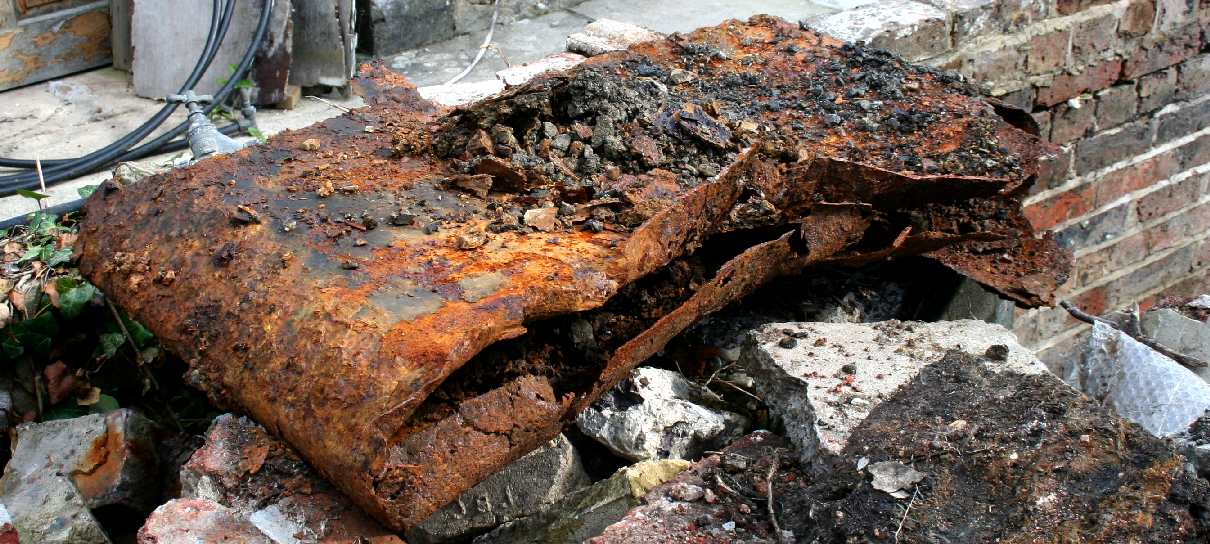|
SEAVAX - FILTRATION
BRICKS & MORTAR - CARRIAGE - DRAINAGE - FACILITIES - FILTRATION - GLASS & PAINT - GANTRY - GIMBALS - HATCHES - HYDRODYNAMICS HISTORY - INSTRUMENTS - LABORATORY - LAMINATING - LOGISTICS - OUR TEST TANK - PROOFING - REVIEWS - SCREEDING - SEAVAX TEST VIDEOS - SLUICE GATE - SOLAR BATTERIES - WAVE MAKING - WIND MACHINE
|
||
|
Hard as one might try, it is impossible to keep water in a tank clear without filtration and chemical treatment, and that is because of algae and other contaminants that will eventually turn crystal clear water into a green pond with frogs, beetles and even fish - if you look away for long enough.
FILTERING CIRCULATION DIAGRAM - Side view of the test tank and underground water holding, or storage tank. The circulation pump is to fit into the chamber just below the surface of a decked area that we are creating to be able to feed pipes conveniently through the (surprise find) solid foundations in brick - for what was obviously a substantial installation back in 1900. In this diagram the tank is in circulation/filtering mode.
FILLING & STORAGE TANK DIAGRAM - Plan view of test tank in filtering/circulation mode. At the turn of a valve the tank can be flushed into the underground storage tank. At the flick of another switch the empty tank can be filled from the storage tank, that can also act as a heat sink for solar heated water.
Filling a tank this size from a regular garden hose pipe running from our storage tank would take 5-7 hours with a fair wind. For this reason and because we need to empty and fill up the tank quickly in between experiments, we are fitting two pumps. One is the usual circulation pump that passes the water through a filter and back into the test tank. The other is to be fitted into an underground chamber on the site that may also double as a heat store. What luck! How many buildings do you know that have a large underground chamber suitable for modification?
When we want to empty the test tank, we flush the water into the underground chamber, but because the former condensation chamber is so deep, the surface mounted circulating pump could never self-prime against that kind of head to be able to pump the water back into the test tank, without doing itself a mischief in the seal department. This is where the second pump comes into play, it can easily pump the water uphill back into the test tank, and with a 270 liters a minute flow rate, the test tank will be filled in around 30 - 50 minutes depending on how deep we want it. Another environmental bonus is that we don't waste water; we recycle it.
COAL & CONCRETE - Alex marked out the area needed to install a decent circulation pump and filter. It looked like an easy job, digging a hole about one meter deep, but this site has a 120 year old industrial history that we are still discovering. The coal is a bit of a clue as to the former uses - and there is a lot of it. Copyright © June 22 2016, all rights reserved. You will need permission from Bluebird Marine Systems Ltd to reproduce this photograph.
SOLID BRICK FOUNDATIONS - Unbelievable! Not only did we hit several cast concrete sections, that were obviously a machinery mount of some sort, but we also discovered a solid brick foundation of some kind, three bricks wide, laid alongside a solid nine inch wall that is the tank. We need to drill two 2" holes through this wall to install the circulation inlet and outlet pipes. Copyright © June 22 2016, all rights reserved. You will need permission from Bluebird Marine Systems Ltd to reproduce this photograph.
PRE-EXISTING - Even more unbelievable! Once excavated a bit more and hosed down, we found that the area we planned making into a chamber, was already a chamber about the same size as we planned, plus it already had a concrete base. Copyright © June 23 2016, all rights reserved. You will need permission from Bluebird Marine Systems Ltd to reproduce this photograph.
INCREDIBLE - By some amazing coincidence, the concrete floor also had wooden mounts in roughly the same position as we will be placing ours. Copyright © June 23 2016, all rights reserved. You will need permission from Bluebird Marine Systems Ltd to reproduce this photograph.
BLACK HOLE - Well not black, but a dark grey, but then further excavations revealed more and more, until we had to call a halt. We don't like the look of that centre brick pier, supporting a whopping concrete block - balanced on a concrete slab. Copyright © June 27 2016, all rights reserved. You will need permission from Bluebird Marine Systems Ltd to reproduce this photograph.
We shopped around on the internet for pump and filtration suppliers, looking as far away as China, but in the end the best value was a local expert in all things pumps. A quick call to Automated Environmental Systems (AES) in Suffolk netted us all the parts we needed in one stop. Their expert quickly worked out what pumps would give us the correct flow rates, and suggested the best value items for our use from their comprehensive range - and all at sensible prices. Without this kind of one-to-one help we could have spent hours working things out. Better still, the parts arrived on time and beautifully packed, and this included all of the fittings we needed to complete the installation. If you need to pump water, why not give AES a call on: 0845 803 5581. Email: sales@automatedenvironmentalsystems.co.uk They are based at: 20b Highbury Road, Brandon, Suffolk, IP27 0ND.
COURIER DELIVERY - An efficient delivery system is just as valuable as a supplier who knows their onions. AES offer a free delivery service on orders over £100. Copyright © July 1 2016, all rights reserved. You will need permission from Bluebird Marine Systems Ltd to reproduce this photograph.
KIT OF PARTS - Unpacked, this is what we ordered for our test tank pumping solution. The maximum operating pressure of the filtration pump is 2.5 bar. The motor is equipped with RCD differential plug for automatic ‘complete’ switch off of electricity in case of water contact, safety rated 30 mA. The pump and filter uses 1½ inch / 50mm stepped glue connections (note that for pipe measurement, Imperial = Internal Bore and Metric = Outside Diameter). Copyright © July 1 2016, all rights reserved. You will need permission from Bluebird Marine Systems Ltd to reproduce this photograph.
PUMPS - [LEFT] The Mega FSF swimming pool filter set offers premium pool filtration performance without the premium price tag. Mega FSF filter sets are suitable for swimming pools and ponds from 25m³ to 72m³. The FSF filter set has a bobbin wound PE lined fiberglass reinforced polyester tank for strength and durability and is equipped with a top mounted six-way valve. Completing the filter set is a skidpack and Mega pool pump with pre-filter. The easy to use six-way top mounted multi-port valve lets you select any of the operations with a simple lever action, the functions of the multi-port valve are filtration, waste, closed, backwash, rinse and re-circulating. Please note you must always switch your pool pump off before changing the position of the multi-port valve. Our Mega FSF500 has a .75kW motor that provides a flow rate of 200 litres a minute.
[RIGHT]
The Conforto VRX submersible sewage pump is a cast iron submersible pump with vortex impeller for the pumping of clean or dirty water and other non combustible liquids. Conforto pumps are designed and manufactured in Italy.
The VRX can be used for lifting fluids from tanks or storage traps, the vortex impeller will allow the passage of sewage and soft solids.
The motor cover, motor casing, pump body and impeller are made from G20 cast iron, the motor shaft is AISI 304 stainless steel, the gaskets are made from nitrile rubber (oil resistant). The mechanical seal is silicon carbide/alumina and the top seal has a lip (oil seal).
PRESSURE GAUGE - This gauge is used to let the operators know when the system needs a flush through. Copyright © July 1 2016, all rights reserved. You will need permission from Bluebird Marine Systems Ltd to reproduce this photograph.
FITTINGS - There is no point having a great pump system without the fittings to connect it up. Brass 1 1/2" male tails and stainless steel hose clips allow watertight connection of the reinforced PVC hose below Copyright © July 1 2016, all rights reserved. You will need permission from Bluebird Marine Systems Ltd to reproduce this photograph.
HOSES - The 1 1/2" green medium duty suction hose has a white spiral helix embedded, providing excellent weatherproofing and crush resistance. This full specification high quality PVC flexible suction and delivery hose has been manufactured especially for water suction and discharge applications with high pressure, chemical and vacuum resistance. The maximum working pressure is 8 bar, the maximum burst pressure is 24 bar. Copyright © July 1 2016, all rights reserved. You will need permission from Bluebird Marine Systems Ltd to reproduce this photograph.
THUMBS UP - Our special projects director, Chris Close, is a hands on engineer. It was a hot afternoon with this area of the grounds being a bit of a heat trap. Not a day to be boring holes in triple thick brick walls, but that did not stop Chris. Copyright © July 5 2016, all rights reserved. You will need permission from Bluebird Marine Systems Ltd to reproduce this photograph.
DIAMONDS - Even using a 60mm diamond tipped wall borer the going was tough, but Chris managed to drill uphill so the the drain in the test tank was at the lowest point of a sloping pool and slightly below floor level. The pipe and brass hose tail will be cemented in place. Copyright © July 5 2016, all rights reserved. You will need permission from Bluebird Marine Systems Ltd to reproduce this photograph.
TEAMWORK - The filtration combo was mounted on a heavy concrete slab that raised the electric pump motor a couple of inches (50mm) above the concrete foundations to allow for any water ingress to drain via a soak-away. The composite base will be cemented and bolted in place for a solid installation. Copyright © July 5 2016, all rights reserved. You will need permission from Bluebird Marine Systems Ltd to reproduce this photograph.
TANK INLETS - There are two feed pipes into the test tank. One comes directly from the underground storage tank and the other is the return from the filtration combination unit. Copyright © July 5 2016, all rights reserved. You will need permission from Bluebird Marine Systems Ltd to reproduce this photograph.
DRILLED - The three holes to and from the test tank are completed. We then lowered the Conforto VRX into the underground chamber to to the left of the filtration combo to pump out the stale water (not seen in this picture. Next, the storage tank will be pressure washed with detergent and refurbished - ending with a final coat of white pool paint. But before any of that two more holes have to be bored in the domed brickwork, one for the test tank flush and one to fill the test tank. Copyright © July 5 2016, all rights reserved. You will need permission from Bluebird Marine Systems Ltd to reproduce this photograph.
MORE GROUND WORKS - Alex and Chris dig around the rim of the underground storage chamber, looking for the rendered outer skin of the dome for a suitable point to drill two holes for the suction and pressure hoses. Copyright © July 7 2016, all rights reserved. You will need permission from Bluebird Marine Systems Ltd to reproduce this photograph.
WELL, WELL - No it's not a well, but it looks much like the well we have on site when looking down the shaft. We needed to pump out this tank where it had become filled with sludge from decaying wood and other ingress. The next stage is to pressure wash the tank and re-paint it white. The hatch frame had rotted away and the glass in the frame was cracked and had fallen into the tank along with anything else that got blown in. Copyright © July 7 2016, all rights reserved. You will need permission from Bluebird Marine Systems Ltd to reproduce this photograph.
PRESSURE WASHED - It took two team members a couple of hours to get the tank back to this condition. They used a bucket and industrial strength rubber gauntlets to scoop up 20 years of sludge and tear down the bunks from conversion to a Nuke shelter in the 1980s. The next step is to plug a couple of leaks in the render tanking, sand and paint with a really tough masonry paint and fix the hoses to the wall. We also need a couple more holes drilled in the dome for heating pipes. The ally ladder may get replaced by a stainless steel item if our welders have a spare moment. Copyright © July 11 2016, all rights reserved. You will need permission from Bluebird Marine Systems Ltd to reproduce this photograph.
ECONOMICS
You may think that this is a lot of work just to have facilities on site, but bear in mind that the Berkeley Wave Tank (circa 1930's), which is basically a long narrow tank designed for pull testing of ship hulls costs about $1500/day to hire. A more modern wave tank costs around $10,000/day.
As we will be conducting tests on our robot vessel and suction-head routinely we could be looking at $300,000 dollars for 30 days of testing in 2016 - if we were to go the hire route. Our DIY tank is costing a little more than at first estimated, but not by much in the grand scheme of things where a lot of the work is done by volunteers and students on minimum wage. We do though help with travel expenses (where we can) and provide free food and drinks to our helpers. The Trust that operates the site has agreed to help out with landscaping and other site improvement expenses where it can to help us stretch our present crowd funding - where visits by interested persons is more frequent and the site needs to be safe.
MORE DIAMONDS - We used a 50mm diamond tipped borer mated to an 800 watt SDS drill to bore entry and exit points for the suction and pressure hoses while keeping the entrance clear for access. Copyright © July 7 2016, all rights reserved. You will need permission from Bluebird Marine Systems Ltd to reproduce this photograph.
NEAT - The hoses fitted nicely with relatively straight runs. At the moment this area is a health & safety nightmare with all this rubble, but it will soon be tucked under decking, that will also preserve the archaeology for generations to come. Copyright © July 7 2016, all rights reserved. You will need permission from Bluebird Marine Systems Ltd to reproduce this photograph.
NEATER STILL - Here we see the hose circuits with the suction pipe from the test tank to the pump at the top of this picture and the return flow as the first hose entering the test tank on the right - and pipe from the underground storage chamber to the test tank below this. The whole team is proud of this installation - with huge thanks to Chris (a volunteer at the moment) for his expertise in hot summer working conditions. Copyright © July 7 2016, all rights reserved. You will need permission from Bluebird Marine Systems Ltd to reproduce this photograph.
DECKING - In order to make this area safe, we are decking over the archaeological remains, with the blessing of Historic England (formerly English Heritage). A hatch will be made to be able to service the pump in the underground chamber, also made of the same treated decking from our old friends at Stamco in Eastbourne. This picture above is of a test fit, just to be sure we have our sums right. Copyright © July 11 2016, all rights reserved. You will need permission from Bluebird Marine Systems Ltd to reproduce this photograph except for private research or review.
INSPECTION HATCH - The decking stops at a convenient support beam, for a hatch to be able to service the filtration plant - also to be made of decking. It's lucky that we have volunteer carpenters who are willing to fit these boards for us, or our costs would go through the roof. Copyright © July 11 2016, all rights reserved. You will need permission from Bluebird Marine Systems Ltd to reproduce this photograph.
ROBOTICS LABORATORY - At the other end of the courtyard, the robotics lab is taking shape. We are mostly using reconditioned bricks dug up on site. Here is a pile of bricks ready to be scraped and washed for Terry to turn back into the rustic wall they were last century (built around C. 1900). Copyright © July 11 2016, all rights reserved. You will need permission from Bluebird Marine Systems Ltd to reproduce this photograph.
BRICK HATCH - Saturday afternoon in the hot sun, Terry constructs a rim wall of bricks to provide safe access to the chamber below once this area is decked over. Copyright © July 16 2016, all rights reserved. You will need permission from Bluebird Marine Systems Ltd to reproduce this photograph.
SUNRISE - Five o'clock in the morning, looking more like a sunset, but this picture was taken on a muggy morning looking across a neighboring field to the weald - an area designated as being of an area of outstanding natural beauty (AONB). Copyright © July 17 2016, all rights reserved. You will need permission from Bluebird Marine Systems Ltd to reproduce this photograph.
ON THE LEVEL - When building any wall, it is important to make sure that the levels are good. In this case the entrance to the underground water storage chamber must be below the decking that is to cover it with sufficient insulation to keep the heat and moisture contained. Copyright © July 17 2016, all rights reserved. You will need permission from Bluebird Marine Systems Ltd to reproduce this photograph.
MARKING OUT - With the brickwork completed for our hatch, we knew the height we were working to. The fabulously stocky upright 8" x 8" posts are a bit of a handful for one person. We found that three men were too many and that two could pop these in place just as effectively. We used a couple of garden trolleys to get these pressure treated trunks from one end of the site to the other. It is important to get the posts vertical and then to use temporary stays to keep them correctly positioned throughout the build sequence. Andrew looks on as rain slows progress. Copyright © August 2 2016, all rights reserved. You will need permission from Bluebird Marine Systems Ltd to reproduce this photograph.
HOSE PIPE - We needed to fill the test tank to see how well our twin tank system worked. It took almost two days to fill the underground chamber using an ordinary hose pipe. Thank heavens we are not on a meter, but draw water from an ancient well. Even so we want to use our water wisely. It took about 25 minutes to fill up the test tank from this chamber using the Conforto VRX - and about the same to empty the test-tank back into the storage chamber using the Mega FSF. Copyright © July 28 2016, all rights reserved. You will need permission from Bluebird Marine Systems Ltd to reproduce this photograph.
DECKING - Be sure to treat the ground to get rid of weeds. We used a heavy duty weed control barrier to stop unwanted growth. You need a good spirit level and a handy carpenter to set the joists accurately to accept your decking. Marking out accurately and cutting the wood to size are of the utmost importance. Alex clamps the joists together ready for our volunteer chippie to nail in place. This part of the operation was paid for by the landlord Trust, with our thanks. Copyright © August 2016, all rights reserved. You will need permission from Bluebird Marine Systems Ltd to reproduce this photograph.
BRICKWORKS - We dug down until we found original wall that was solid enough to work from. Andrew used sharp sand to lay recycled bricks to build up the wall above ground level. You will need to install a damp proof membrane once the height of the wall is a few courses above and clear of the grass. Copyright © Sept 2016, all rights reserved. You will need permission from Bluebird Marine Systems Ltd to reproduce this photograph.
WOODWORK - The system for the roof joists is much the same as for the floor joists, except that you need ladders to mark, cut and fit them - and a good head for heights. Do not take any chances when working aloft. Use a work belt to carry your tools, nails and screws, so leaving your hands free - just in case you need to grab something in a hurry. Copyright © Sept 2016, all rights reserved. You will need permission from Bluebird Marine Systems Ltd to reproduce this photograph.
ROOF - In making the site safe to walk around, in health and safety terms, we have made a useful area for training staff, lectures on ocean plastic and other events. With just a bit more effort this area may also be used as an observation room for the test tank. All we need now is a couple of dry days to sort the roof out.
This work was paid for by the Trust that manages the site with our grateful thanks. The project is making steady headway with help from all our volunteers and material contributors as a magnificent team effort. There will be no charge for us to use this facility, so long as it is in the interests of cleaning our oceans or for related research. Copyright © 29 Sept 2016, all rights reserved. You will need permission from Bluebird Marine Systems Ltd to reproduce this photograph.
FRIDAY 29th JULY 2016 - Chris Close, watches plastic being sucked into the SeaVax development model. We simply scattered plastic across the surface of the test tank for this experiment. It was a hot day but still the water was cold. That is why we are heating it for our testing programme. Copyright © July 29 2016, all rights reserved. You will need permission from Bluebird Marine Systems Ltd to reproduce these photographs.
RECIRCULATING WAVE - Without re-modeling the steps that were in the lower left hand corner of this diagram, we would not have been able to install the turning vanes to be able to use the tank in recirculating mode. In this mode we can measure the drag of a hull, or any other object, even those submerged, such as a submarine - and for a fraction of the cost of other facilities.
BOILER - We are note sure what this iron/steel tank might have been, but it is part of the electricity generating machinery that operated on part of the site around 1909. You can see the coal that it was buried with along with ash and brick rubble. This was found in a section of the base foundations of a part of the wooden building that was sold off in 1936. We aim to honour that part of the site and preserve the mountings with protective decking and other weather protection - while still maintaining an active use. If you have any information about this site please contact: Historic England, Eastgate Court, 195-205 High Street, Guildford, GU1 3EH. Tel: 01483 252020. Email: southeast@HistoricEngland.org.uk. The bulk of the original buildings remain on site virtually intact. Copyright © July 1 2016, all rights reserved. You will need permission from Bluebird Marine Systems Ltd to reproduce this photograph.
LINKS & REFERENCE
https://www.automatedenvironmentalsystems.co.uk/ sales@automatedenvironmentalsystems.co.uk southeast@HistoricEngland.org.uk https://historicengland.org.uk/ https://avaaz.org/
BRICKS & MORTAR - DRAINAGE - FILTRATION - GLASS & PAINT - GANTRY - HYDRODYNAMICS HISTORY - INSTRUMENTS - LABORATORY - LOGISTICS - OUR TEST TANK - SEAVAX TEST VIDEOS - SLUICE GATE - WAVE MAKING - WIND MACHINE
|
||
|
This page is Copyright © 2018 Bluebird Marine Systems Ltd. The names Bluebird™, Bluefish™, Miss Ocean™, RiverVax™, SeaNet, SeaVax™, and the blue bird & fish in flight logos are trademarks. All other trademarks are hereby acknowledged.
|
